Muscle Receptors and Spinal Reflexes
1/107
There's no tags or description
Looks like no tags are added yet.
Name | Mastery | Learn | Test | Matching | Spaced |
|---|
No study sessions yet.
108 Terms
________ are responses initiated by stimulation of peripheral sensory receptors that result in a stereotyped pattern of muscle contraction that is not under voluntary control.
Reflexes
Reflex responses do not require higher brain centers, although the ______ of the reflex response elicited by a particular peripheral stimulus can be modulated by higher centers.
strength
Reflex responses are _______ than voluntary ones. They are important in a range of situations - for rapidly correcting voluntary movements in progress, for maintenance of posture, to protect overcontracted muscles, or to withdraw from painful stimuli.
faster
Reflexes can be thought of as being "________" into the nervous system to ensure that stimulus response patterns necessary for survival are executed rapidly and faithfully. Monitoring reflexes is important in _________.
hard wired
clinical diagnosis
The skeletal motor system ______ act alone. Instead, it interacts with ________ input for an integrated output.
The ability to execute ________ movements with appropriate force, accurate direction and precise timing depends upon integrating numerous types of sensory input.
Sensory input is also critical for _________.
does not
sensory
voluntary
spinal reflexes
RECEPTORS: ________________, a sensor for muscle length and speed
Muscle Spindle Organ (MSO)
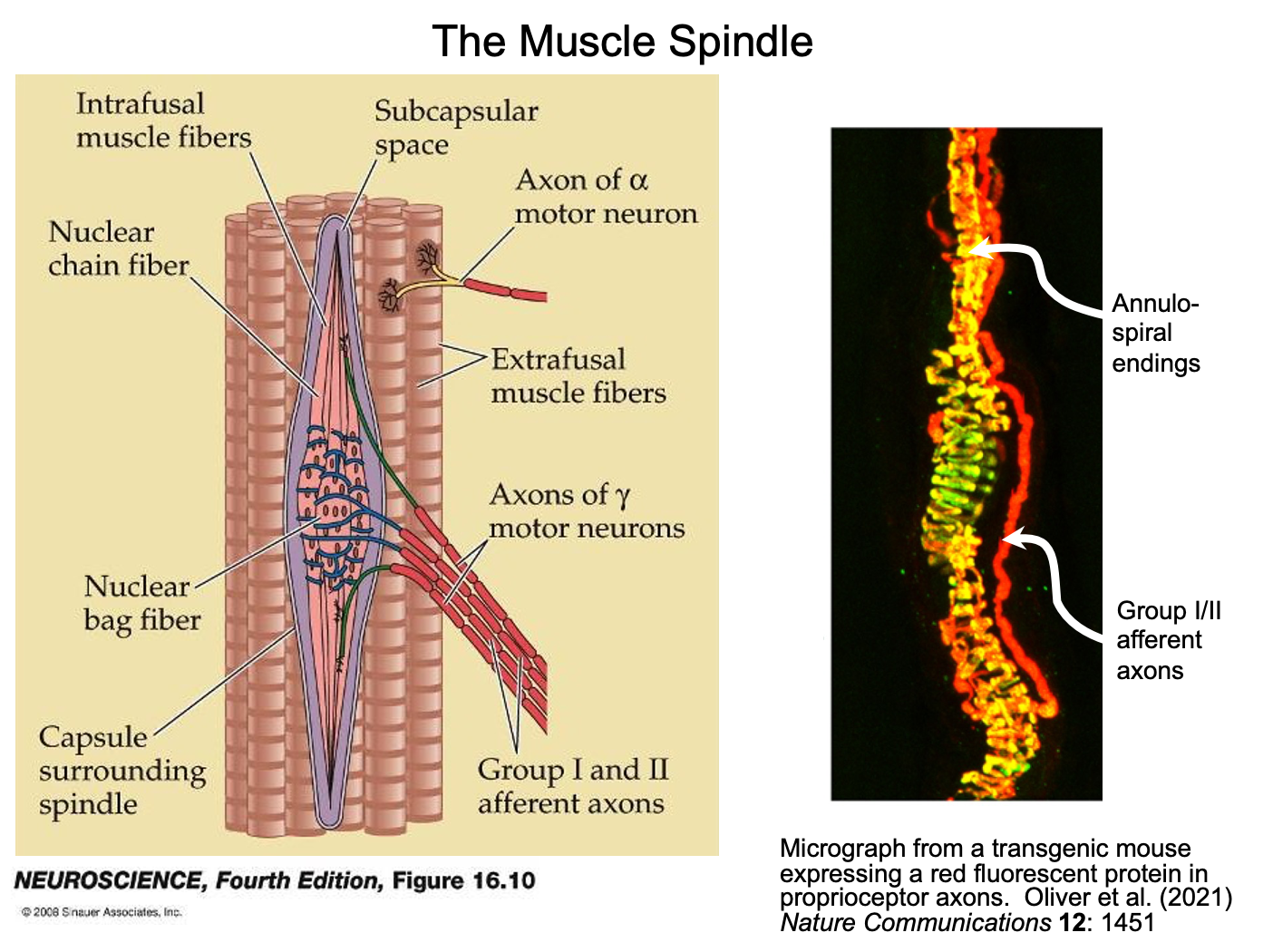
Muscle spindle organs are named for their _________ shape.
spindle (elliptical)
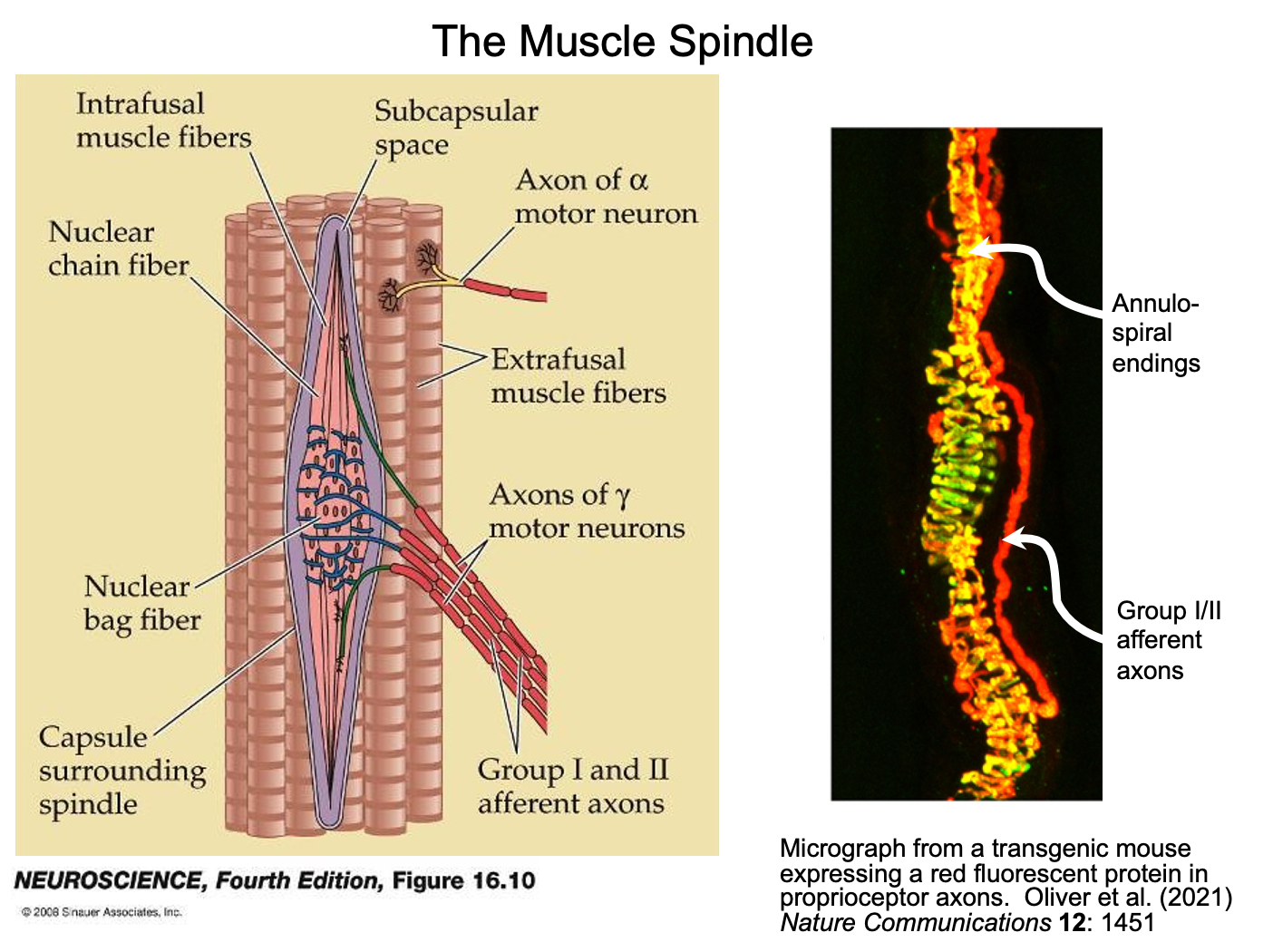
Each muscle spindle organ is composed of about 2-10 thin specialized ____________ encased together into a connective tissue sheath or “spindle” within the _____ of the muscle.
intrafusal muscle fibers
belly
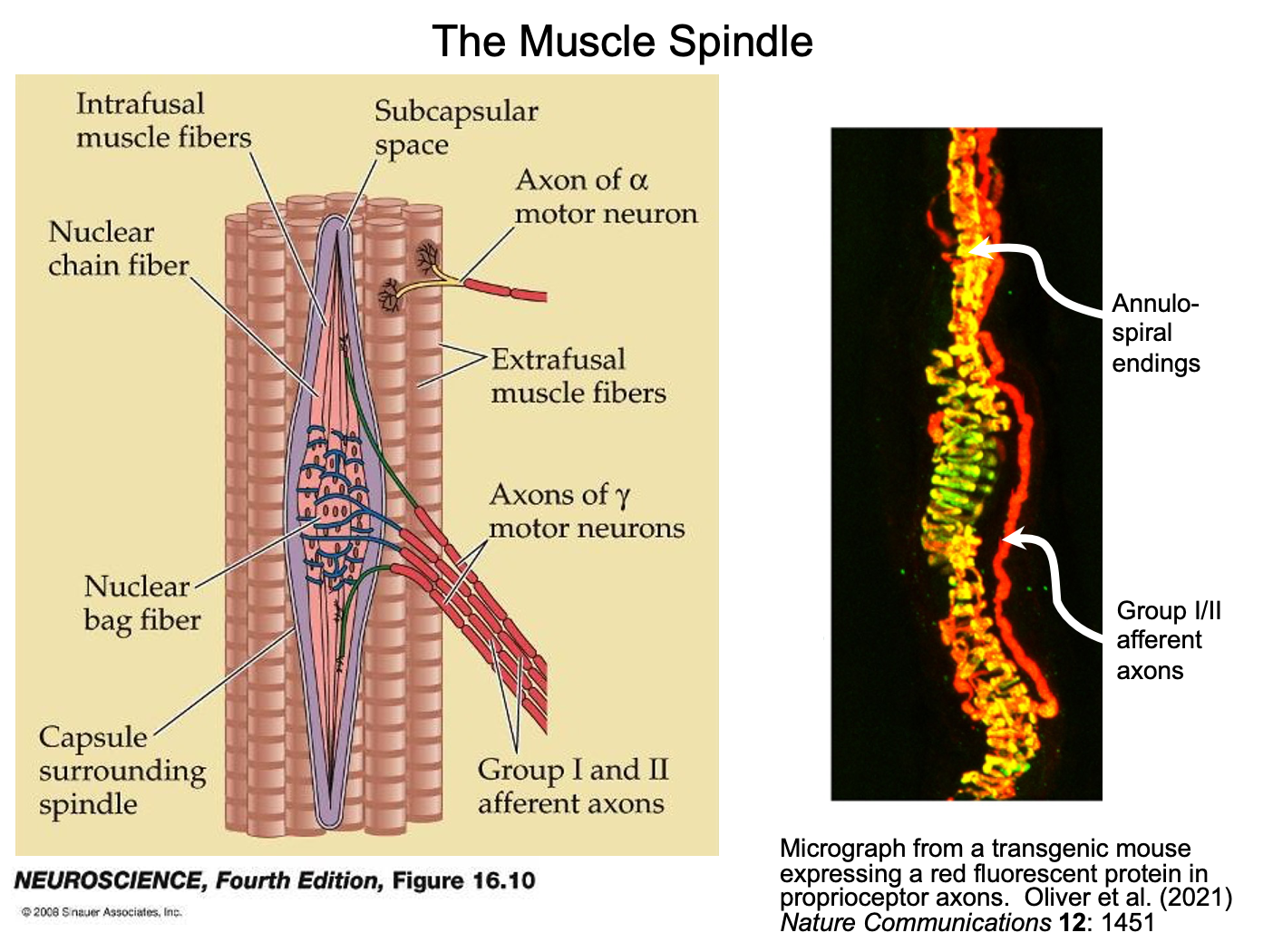
The principal thick myofibers that form the bulk of the muscle and generate all the contractile force are thus termed ____________.
extrafusal fibers
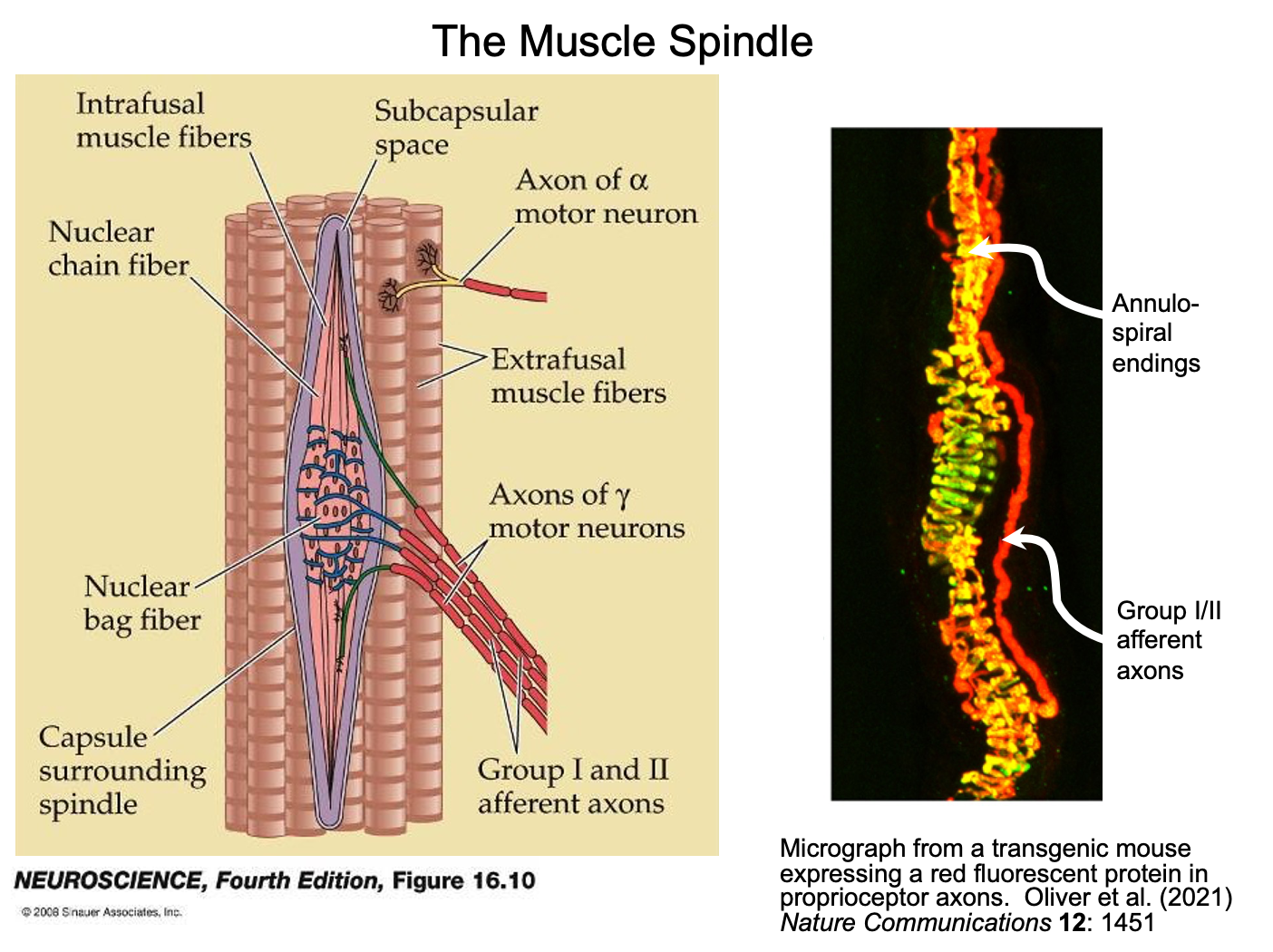
The _____________ are specialized to be sensory receptors rather than to generate force.
intrafusal muscle fibers
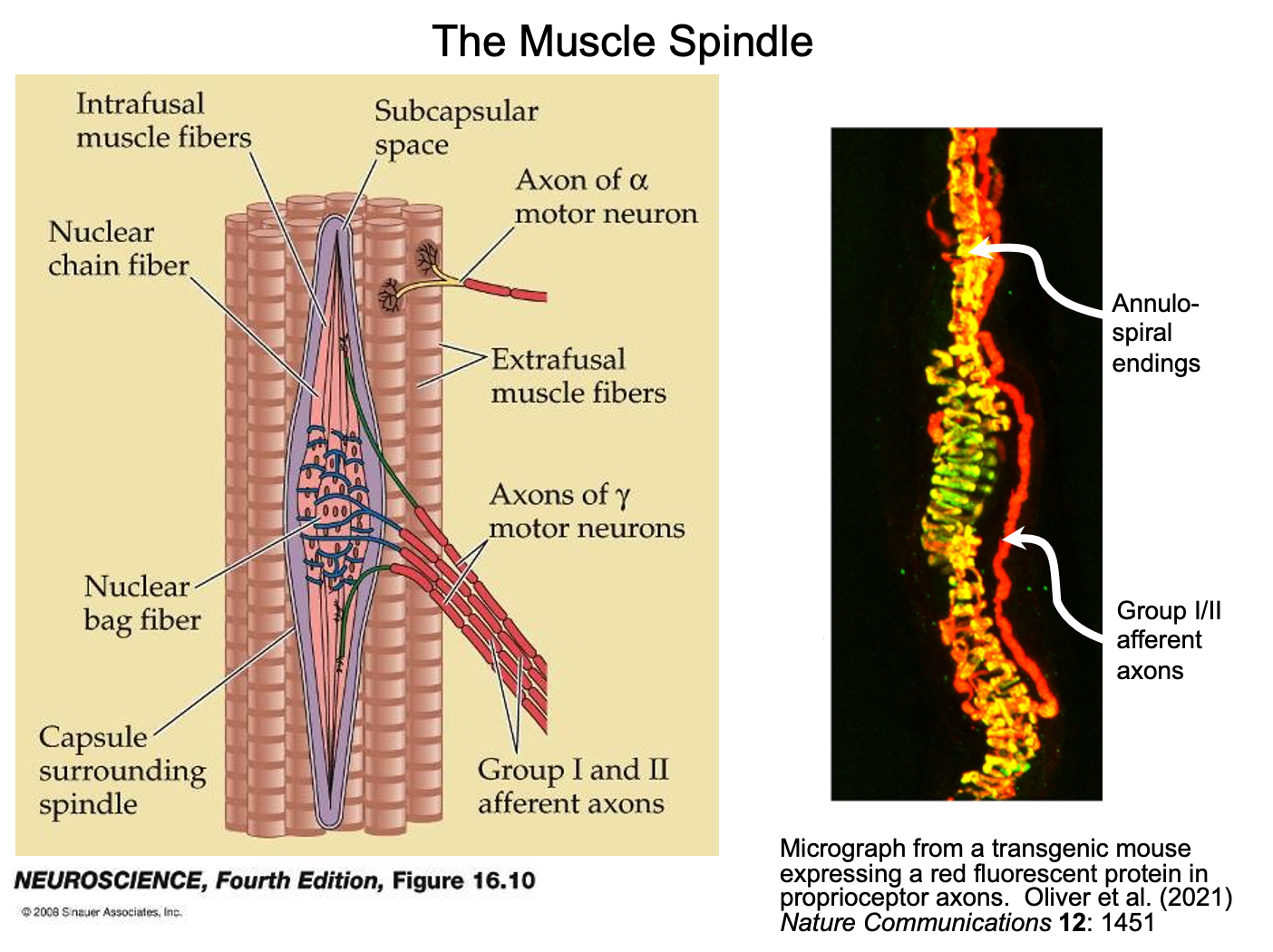
The spindle organs attach to the same ______ as the extrafusal muscle fibers, are oriented ______ to the extrafusal muscle fibers, and experience the same changes in _______ as do the extrafusal fibers.
tendons
parallel
length
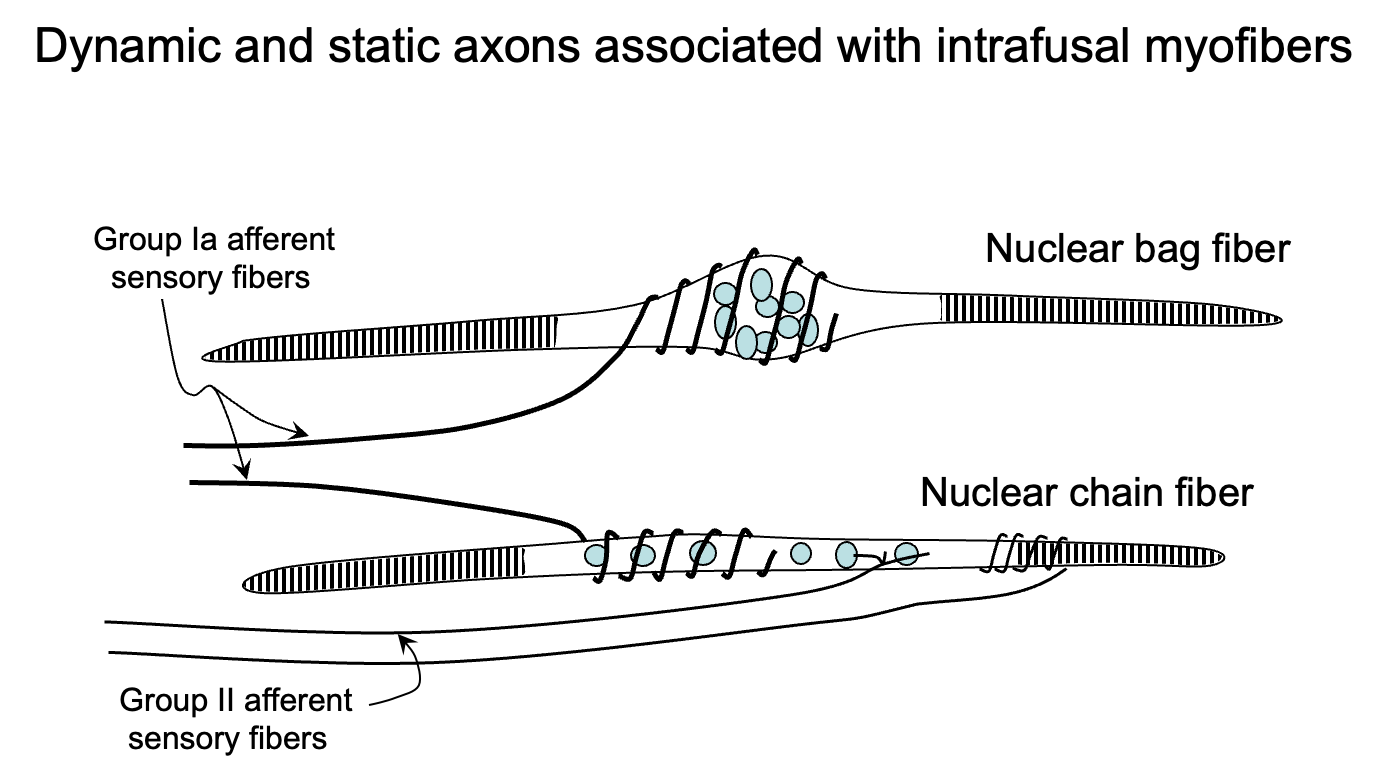
Muscle spindle organs contain two specialized types of intrafusal muscle fibers:
Nuclear bag fibers
Nuclear chain fibers
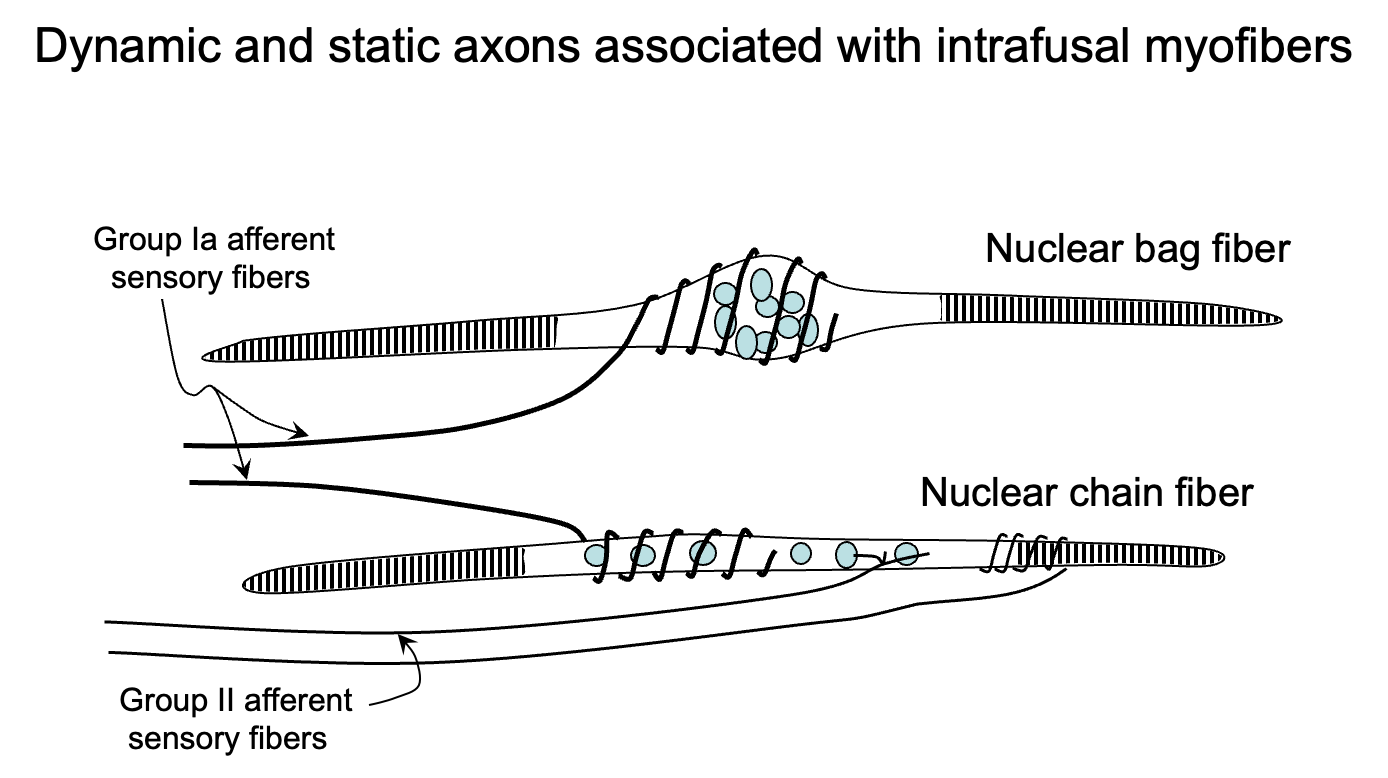
The nuclei of nuclear bag fibers are grouped together in a "bag"-like region in the ______ of the fibers, whereas the nuclei of the nuclear chain fibers are distributed ________ of the fiber.
middle
along the length
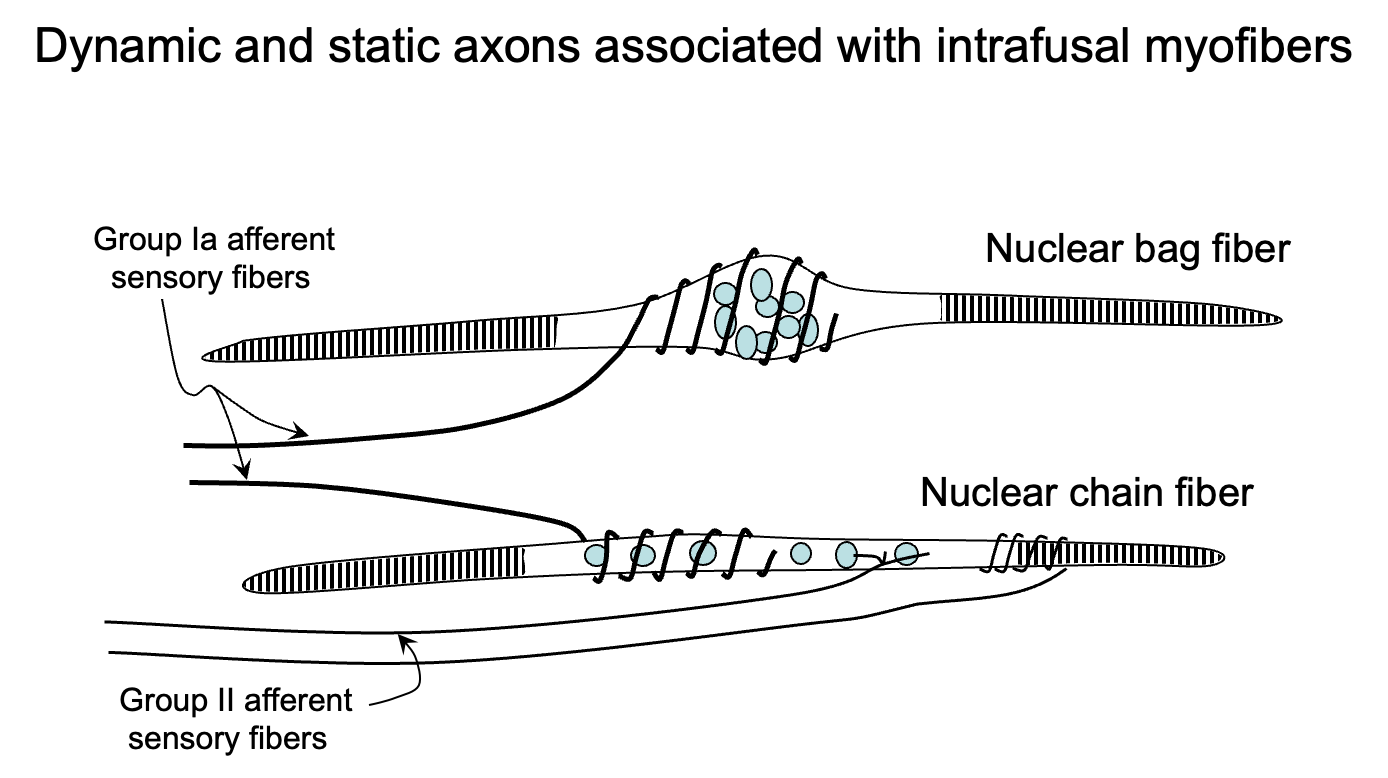
In addition to the intrafusal fibers, the muscle spindle includes two types of nerve fibers – _______________ with mechanosensory endings, and ____________. These mechanosensory endings are intimately associated with the intrafusal fibers and report on changes of ______ that the intrafusal fibers undergo.
large diameter myelinated axons
small diameter γ motor axons
shape
The largest diameter sensory fibers, the so-called ________ fibers have “annulospiral” nerve endings i.e. they wrap around the middle of most intrafusal myofibers.
Group Ia
A second type of sensory fiber, the ______ afferents, form “flower spray” endings on the nuclear chain (and occasionally, on bag) fibers.
Group II
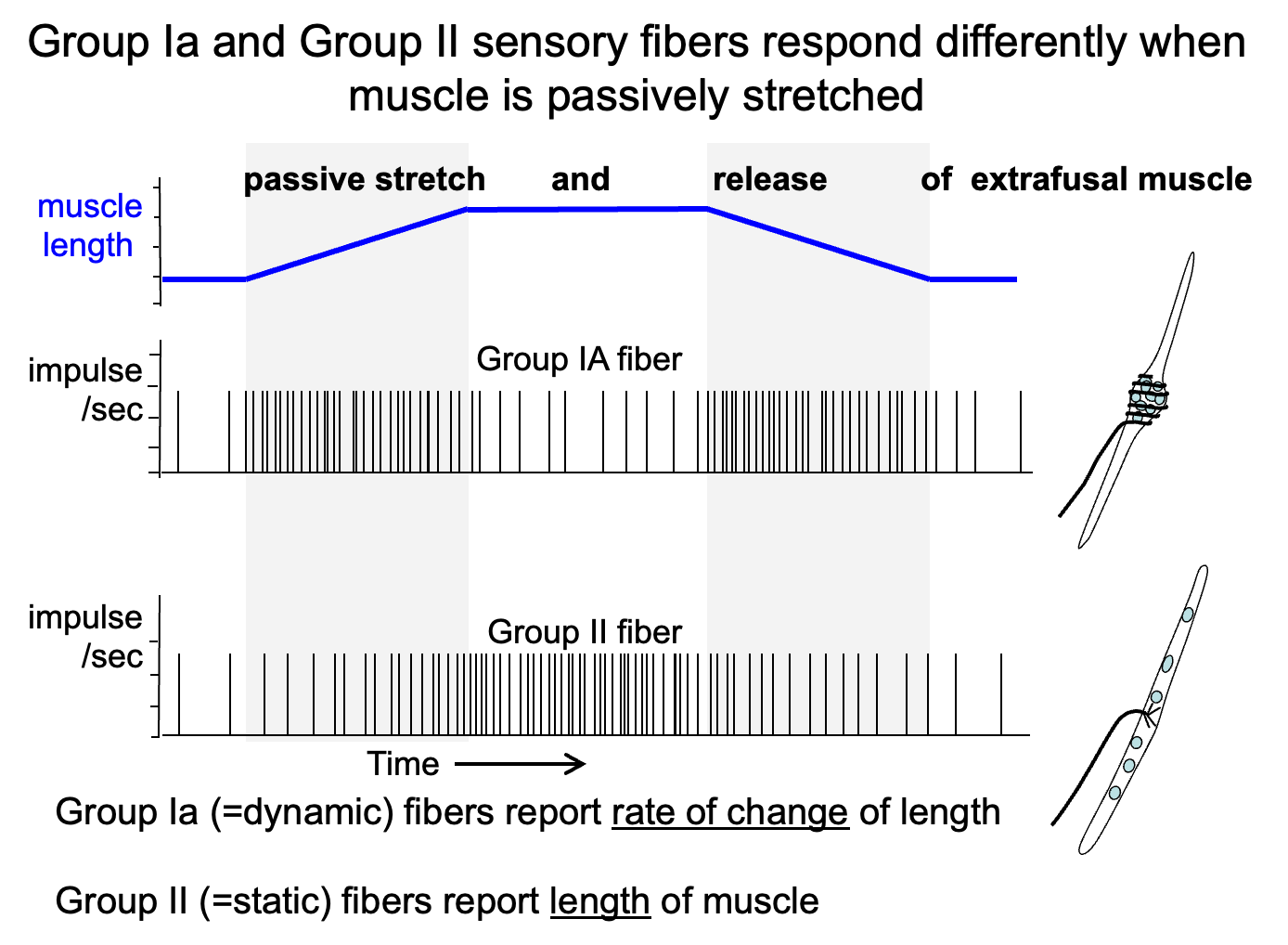
If a muscle is passively stretched, the increase in ______ distorts intrafusal fibers. Mechanosensitive ion channels in the endings of sensory nerve fibers respond to this deformation by _______, thereby producing a generator potential depolarization. This graded generator potential triggers action potentials via mechanisms similar to those you have learned for other sensory receptors (e.g. the Pacinian corpuscle).
length
opening
________ (=dynamic) fibers report rate of change of length
Group Ia
________ (=static) fibers report length of muscle
Group II
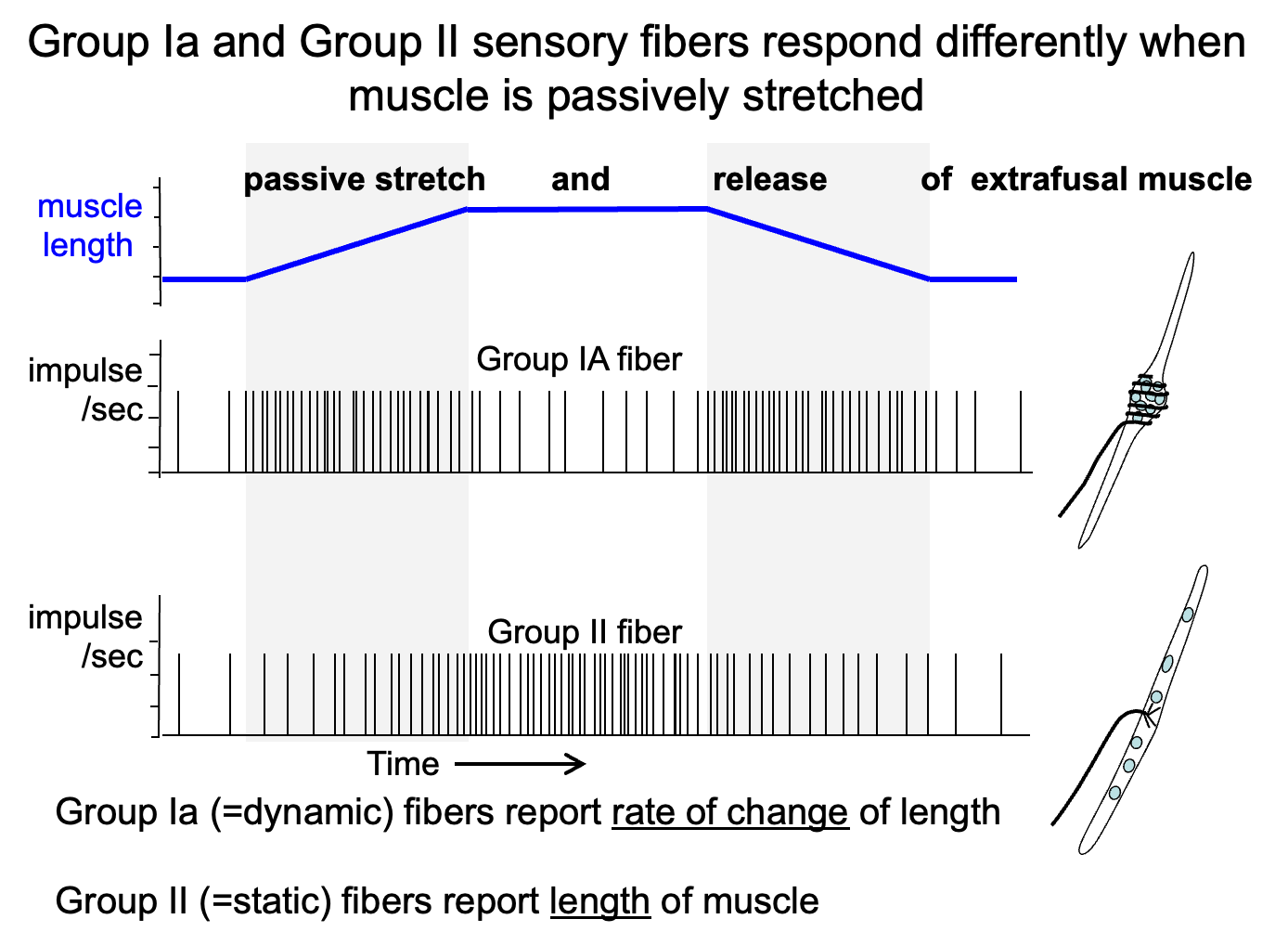
In response to passive stretch of the muscle, the _________ give a phasic response: they fire rapidly when the stretch is first applied, but then quickly reduce their firing rate, even if the stretch is sustained.
The high conduction velocity of the _______ (120 meters/second) makes them well suited for conveying information about rapid changes in muscle length. Hence, these nerve fibers are termed “______” and their discharge gives a measure of the muscle length as well as the velocity (rate of change) of muscle stretch.
annulospiral endings
group Ia fibers
dynamic

The _________ sensory endings are sensitive to sustained stretch and slow changes of muscle length. These endings are connected to thinner myelinated _________. These receptors fire action potentials at rates proportional to the degree of muscle stretch. Thus, the group II fibers, also termed “_____”, give information about absolute muscle length.
“flower spray”
“group II” fibers
static
The neuronal cell bodies of the Group Ia and Group II sensory fibers are located in the ______________ alongside other types of sensory neurons.
Dorsal Root Ganglia (DRG)
REFLEX: ______ (= Monosynaptic = Tendon Tap = Myotactic) Reflex
Stretch
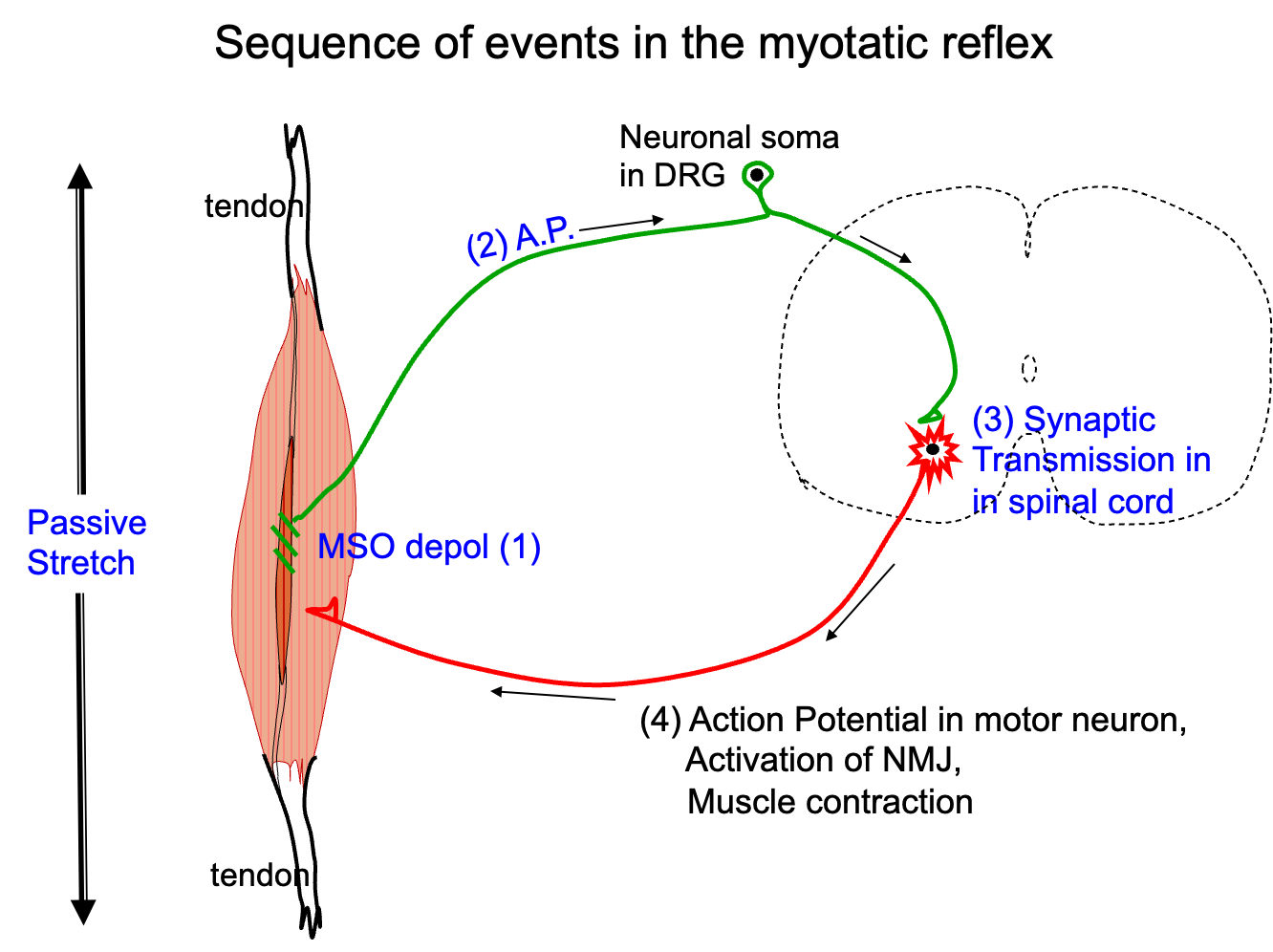
The myotactic relex is the simplest of the spinal reflexes. It requires only two neurons, a _________ innervating the annulospiral endings of a muscle spindle organ, and an ________ innervating extrafusal fibers in the same (homonymous) skeletal muscle.
sensory neuron
α motor neuron
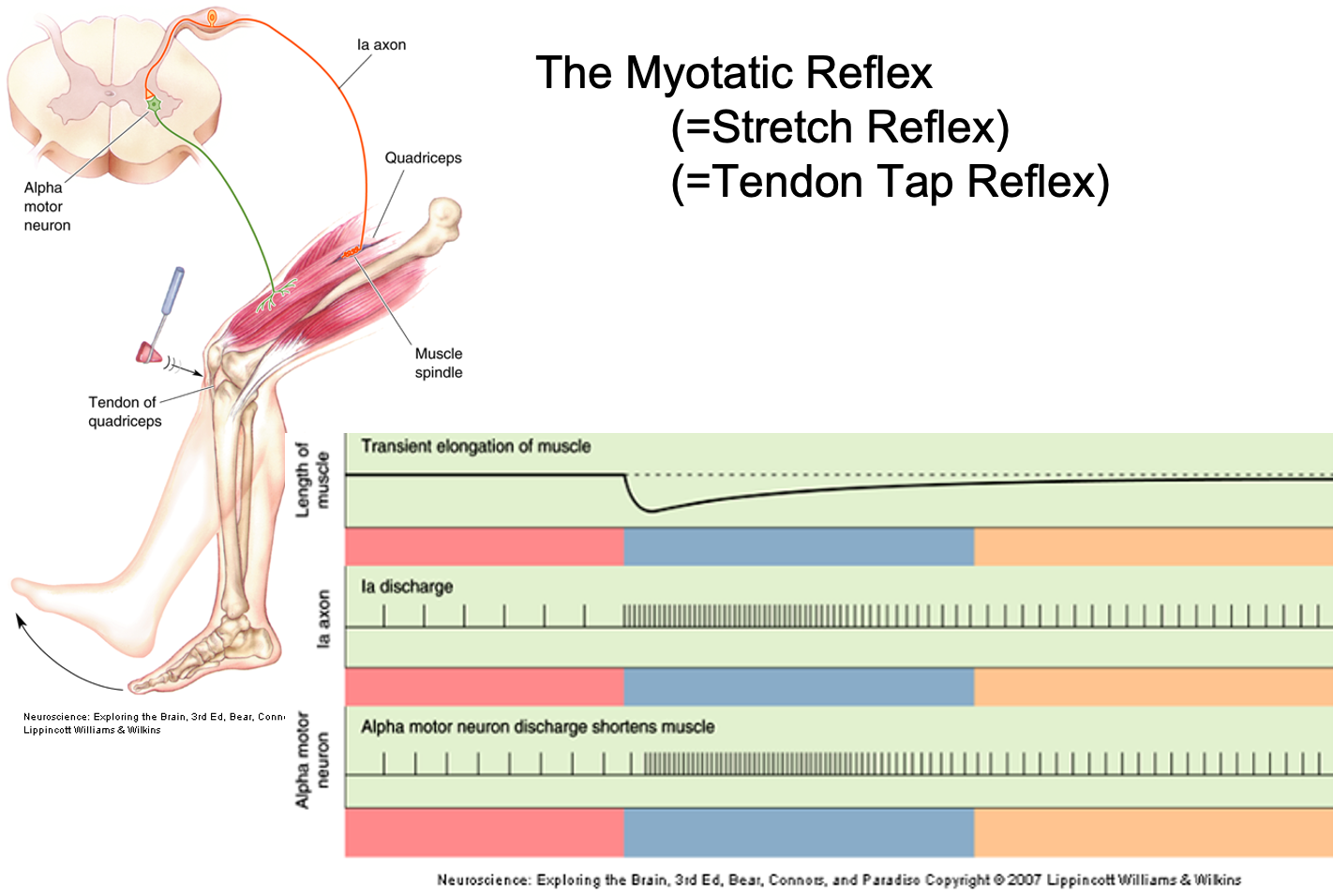
Central branches from the sensory neuron make _____________ excitatory synapses on α motor neurons innervating their muscle of origin, i.e., axons of group IA annulospiral receptors within the quadriceps muscle synapse directly onto quadriceps α motor neurons.
direct (monosynaptic)
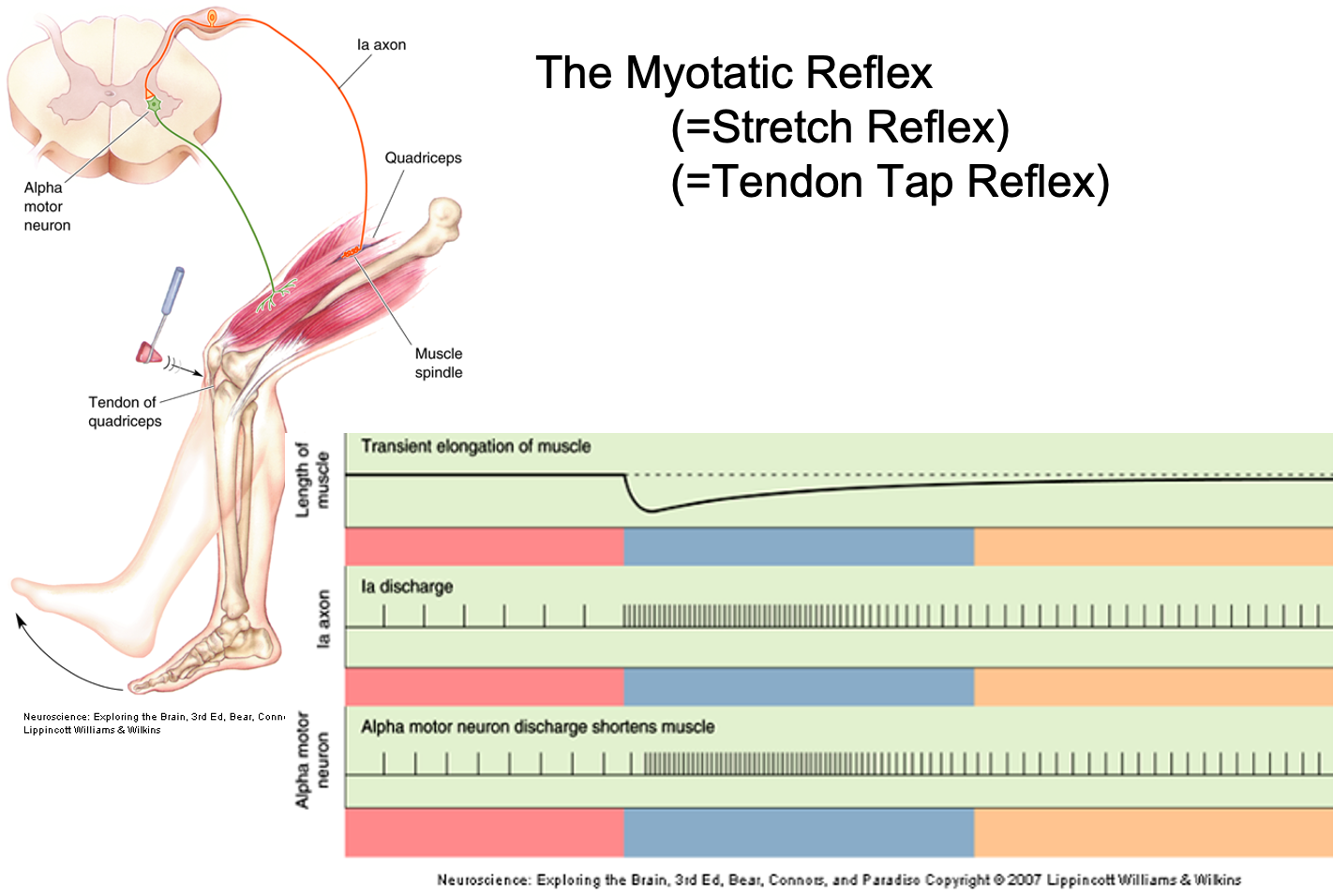
When the quadriceps muscle is stretched passively, all the ________ associated with it are activated simultaneously. Thus, the pool of __________ for the entire gastrocnemius muscle receives simultaneous excitatory input. As a result, the entire muscle twitches.
1a afferents
α-motor neurons
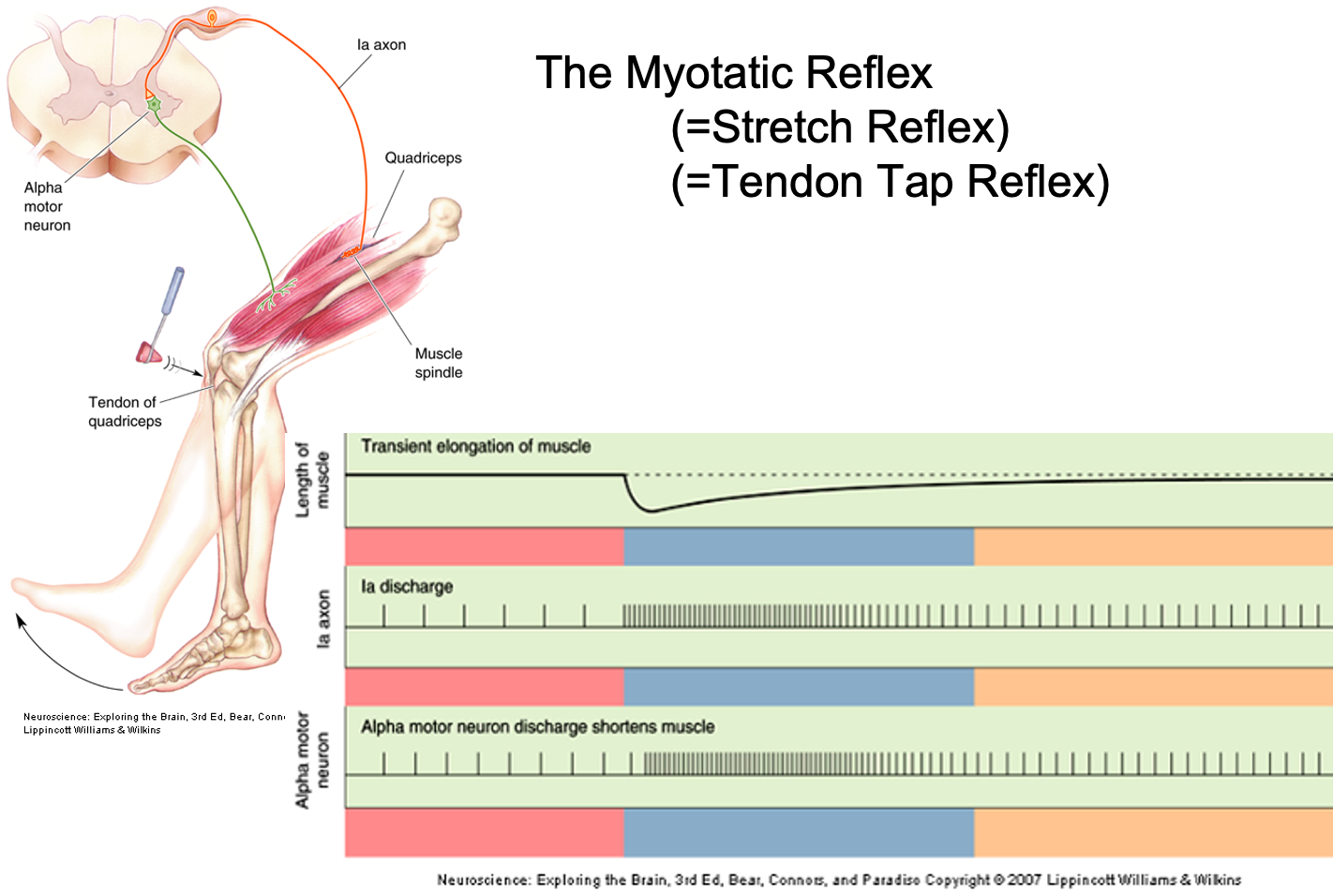
This _____________ of annulospiral afferents can be achieved by suddenly stretching the muscle, for example, by tapping that muscle's tendon .
synchronous activation
This synchronous activation of annulospiral afferents can be achieved by suddenly stretching the muscle, for example, by tapping that muscle's tendon. This triggers the stretch reflex, also called the myotatic reflex, through the following steps:
Stretching the muscle and its resident muscle spindle organ produces a depolarizing generator potential in the group IA annulospiral sensory terminals of the spindle.
The receptor potential is converted into one or more action potentials, which propagate along group IA afferent fibers toward the spinal cord.
In the spinal cord, glutamate neurotransmitter is released from IA presynaptic terminals. Each 1A afferent elicits only a small EPSP in the postsynaptic α-motor neuron. Because branches of several 1A afferents converge on α-motor neurons, EPSPs can be summated.
The summed EPSPs exceed threshold for many motor neurons, causing them to fire one or a few action potentials. This excitation propagates to the motor nerve terminals, leading to contraction of all the muscle fibers innervated by those motor neurons.
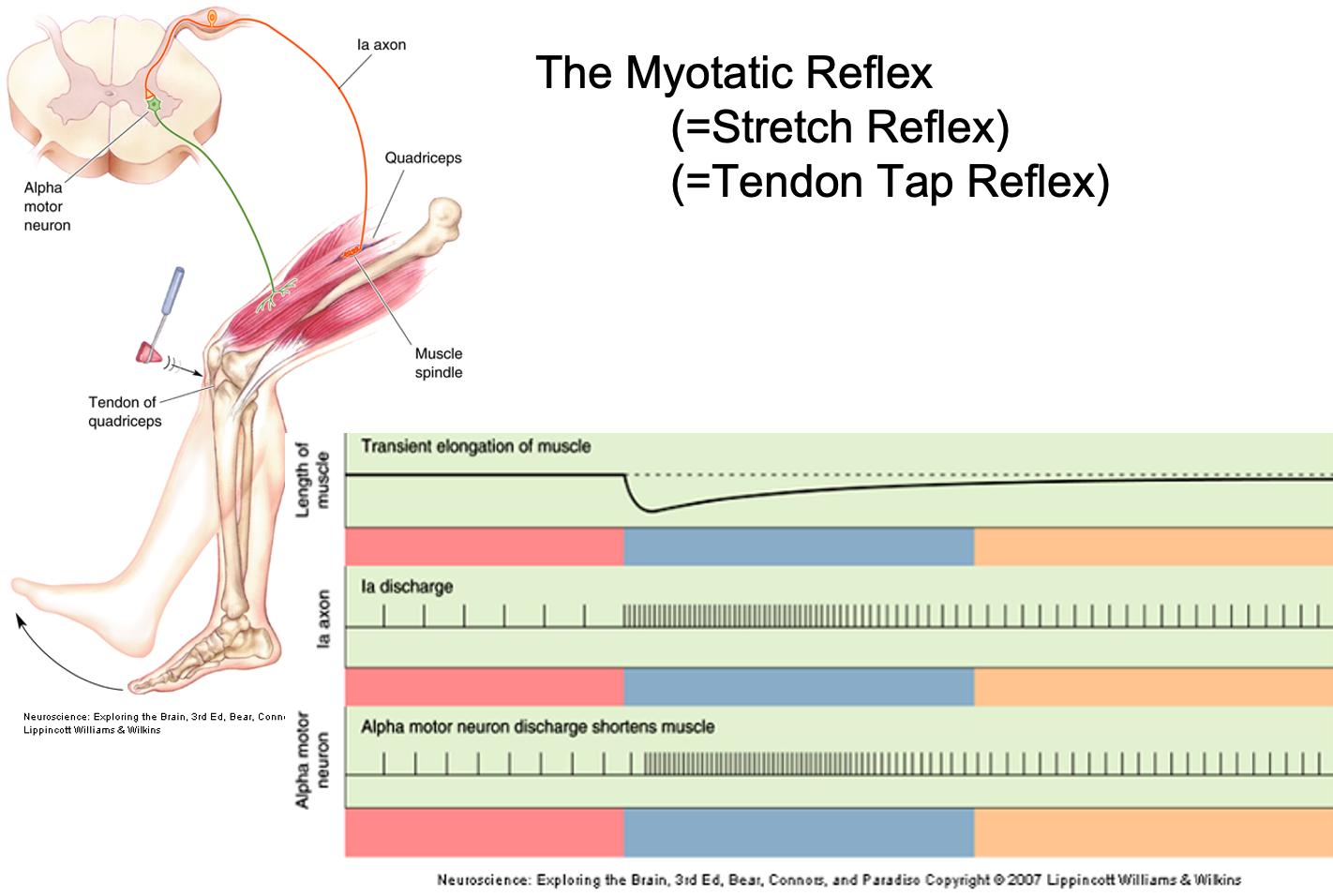
Because the sensory axon connects _______ to α-motor neurons in the spinal cord, this simplest of reflexes is termed monosynaptic.
directly
_____________ spindle endings are responsible for the response in this reflex because the tendon tap produces a very small but rapid stretch of the muscle.
The __________ receptors in the muscle spindle organ do not contribute to the tendon tap reflex because they are more sensitive to overall length, which has changed relatively little.
Both the _________ receptors contribute to the reflex response produced by slower changes in muscle length.
Group 1a dynamic
static (Group II)
tonic and phasic
Because it uses the largest, fastest afferent and efferent axons, and because it involves only one central synapse, the stretch reflex is obviously built for speed.
In humans, the myotatic reflex, with a latency of only about 30 msec from the tendon tap at the knee to the visible knee jerk, is the _____________.
In comparison, voluntary movements, because they involve synapses between _______ and conduction along __________ in motor circuits, typically require over 150 msec from the stimulus to the movement response.
fastest motor reflex
multiple neurons
multiple axons

REFLEX: _______________ Innervation in the Stretch Reflex
Homonymous and Synergist
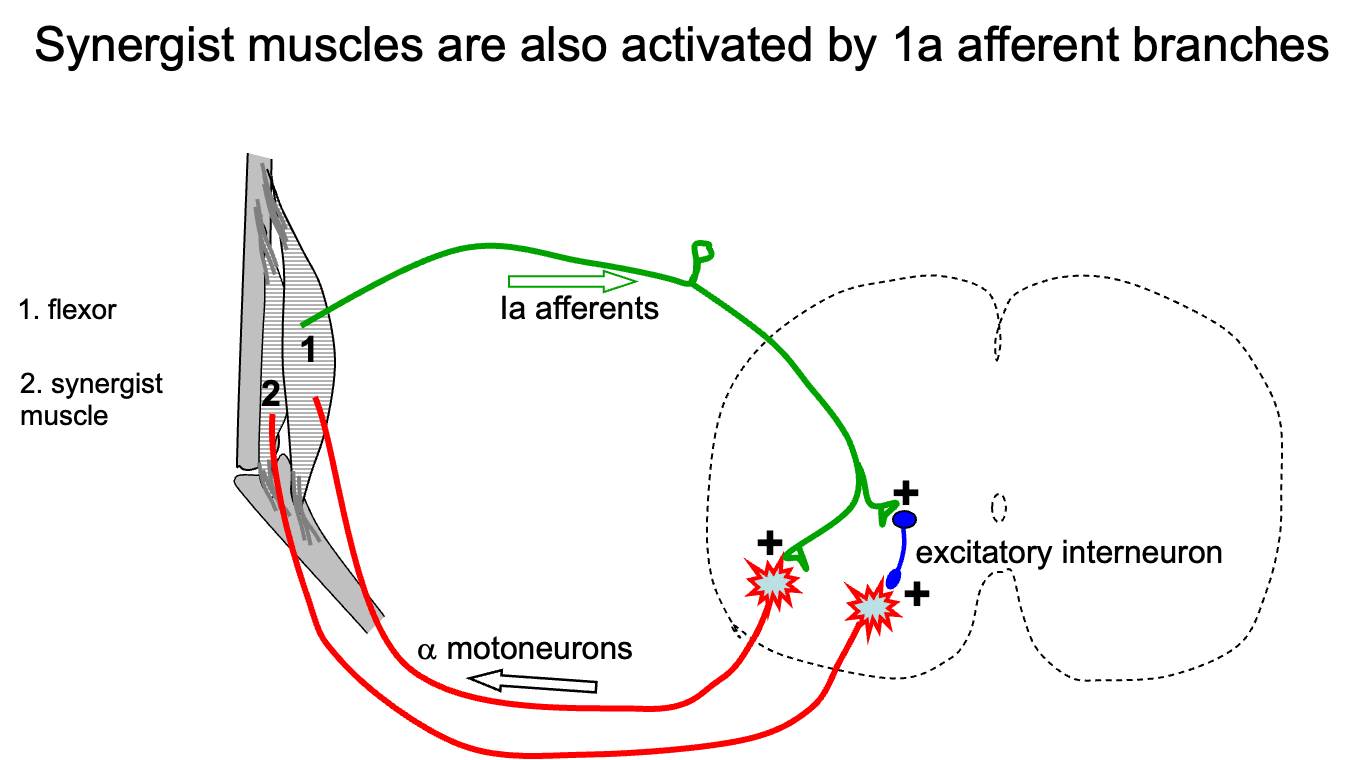
Muscles can drive movement or exert force only by _________. Hence, to permit movement in both directions, most joints have a ________ arrangement of muscles.
A muscle that pulls a joint into a flexed position is opposed by an antagonist muscle on the opposite side that pulls the joint to an extended position. Muscles that pull a joint in approximately the same direction are called __________.
shortening
reciprocal
synergists
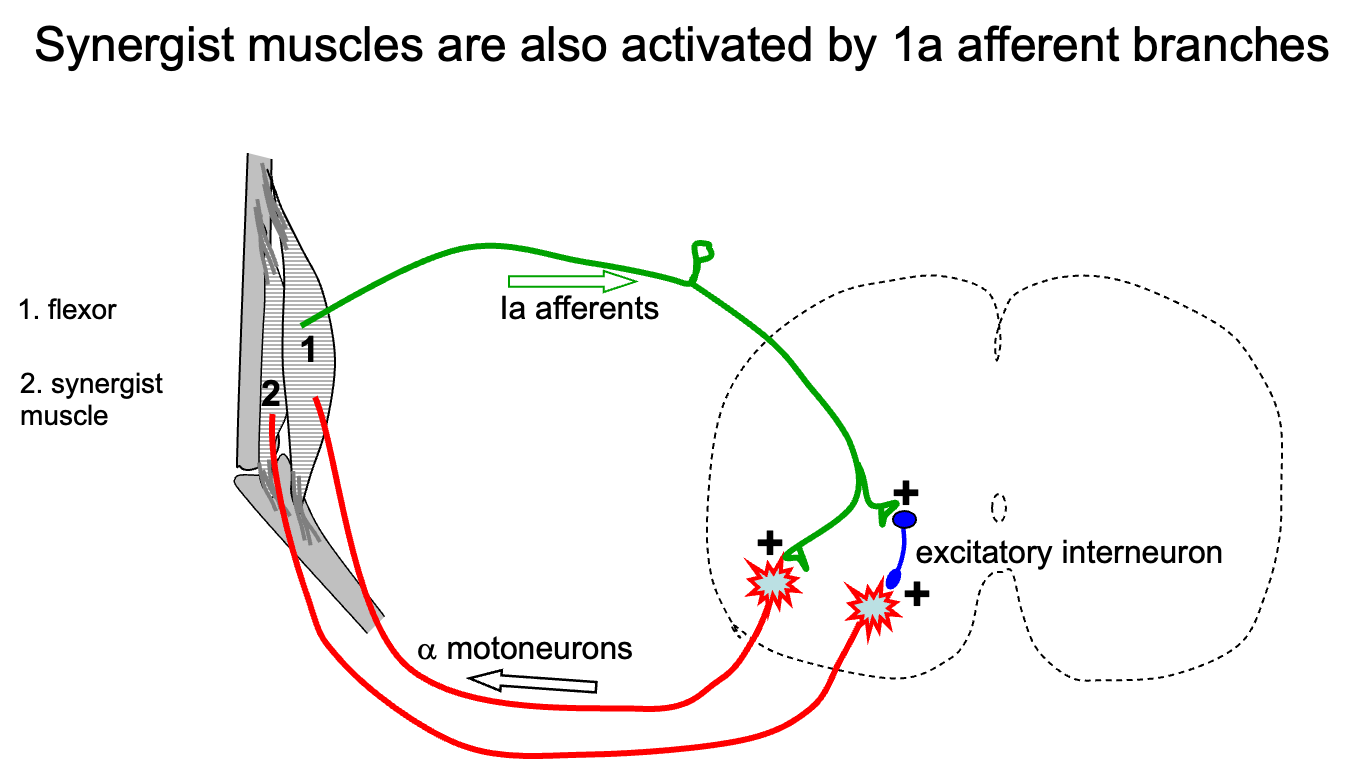
The primary afferent fibers from the annulospiral endings of muscle spindle organs ______ once they arrive in the spinal cord.
In additional to the excitatory synapses on the homonymous (same) muscle, other branches of the 1A afferents form weaker excitatory synapses onto ______ neurons innervating ________ muscles.
Thus, the load is spread across muscles that exert force in a _______ direction.
branch
α-motor
synergist
similar
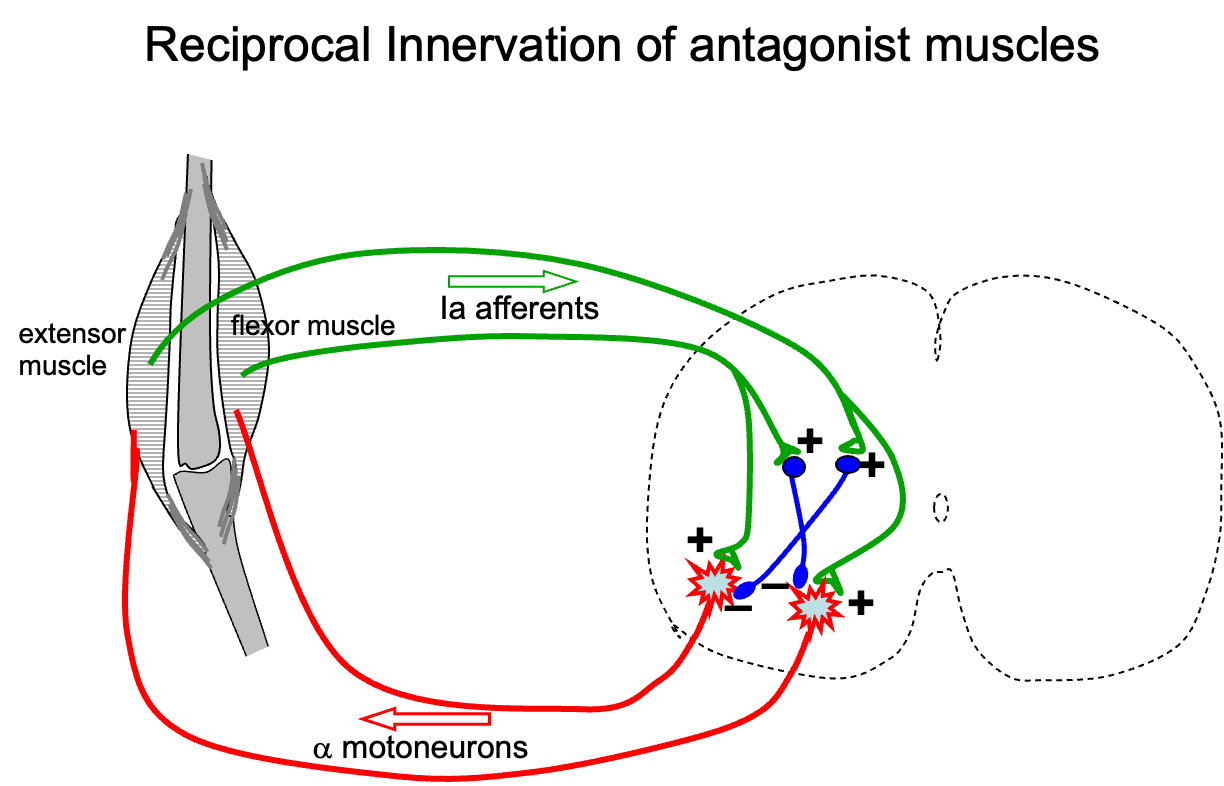
REFLEX: __________ in the Stretch Reflex
Reciprocal Inhibition
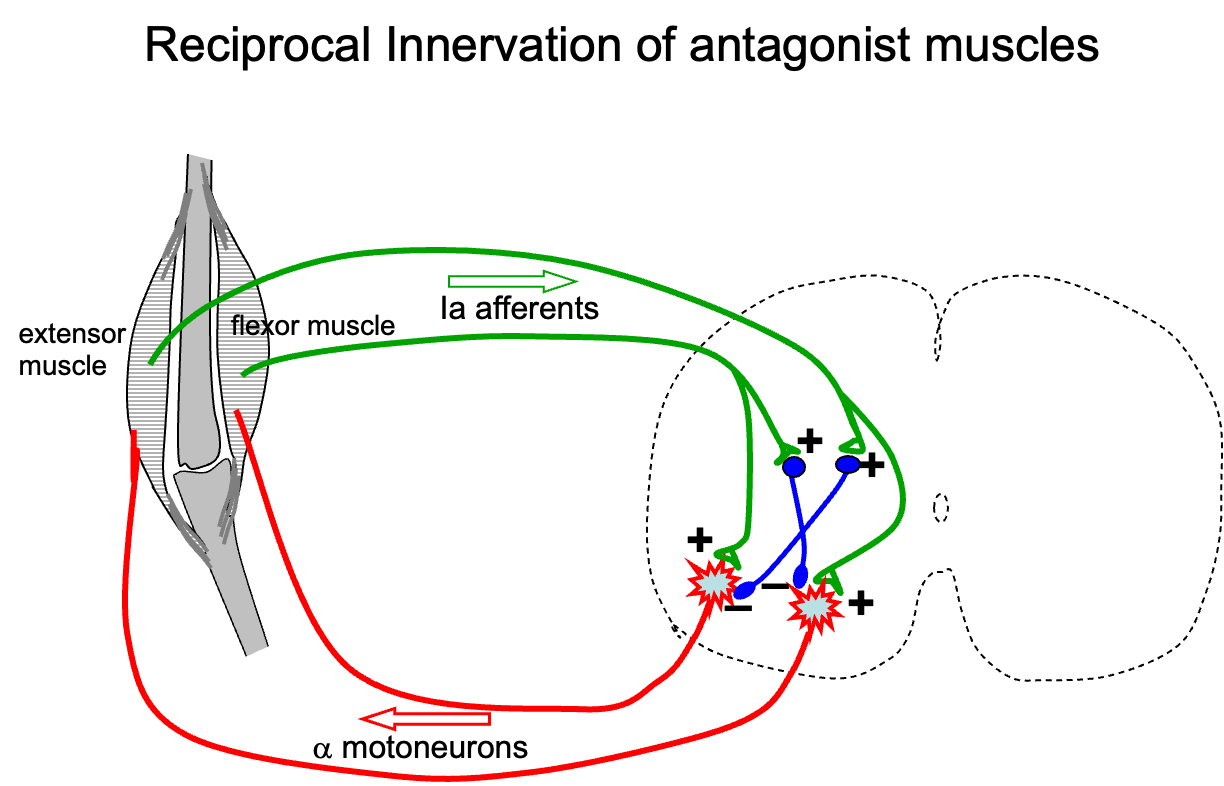
Branches of the afferent fibers from stretch receptors also form excitatory synapses on spinal cord ________ which inhibit the α-motor neurons innervating antagonist muscles.
Thus, when one muscle is actively _________, the motor neurons innervating the antagonist muscles are inhibited.
This arrangement, called reciprocal innervation, prevents the antagonist muscle from __________ the intended movement or reflex.
interneurons
contracting
opposing
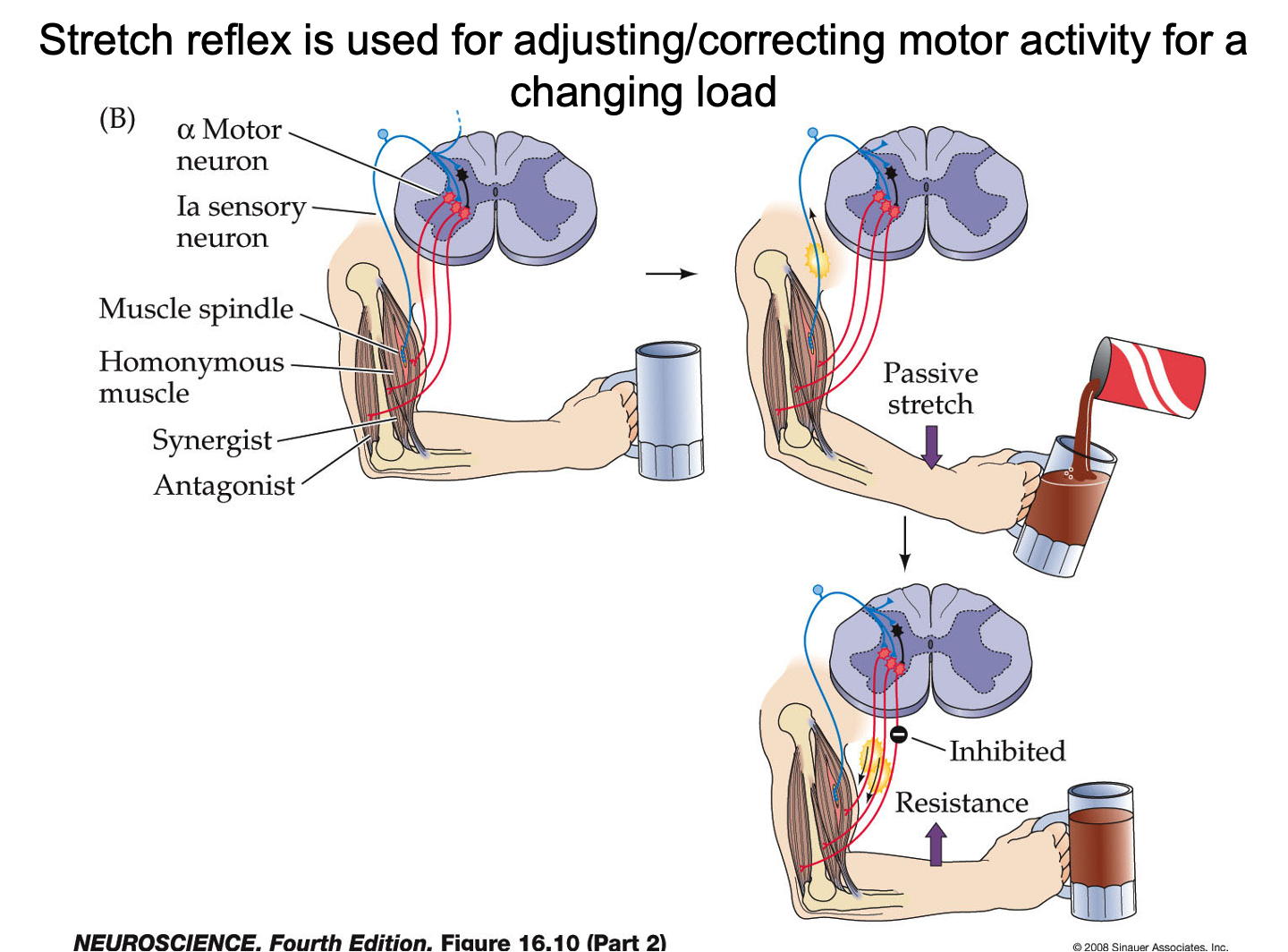
Shows how the stretch reflex might be used in a real-world motor sequence.
As the load (weight of cup) on the flexor ________, the forearm is pulled down, exerting a passive stretch on the flexor muscle.
The small activation of the spindle afferents then slightly ________ activity in the α-motor neurons for the flexor, returning the joint to its original position.
increases
increases
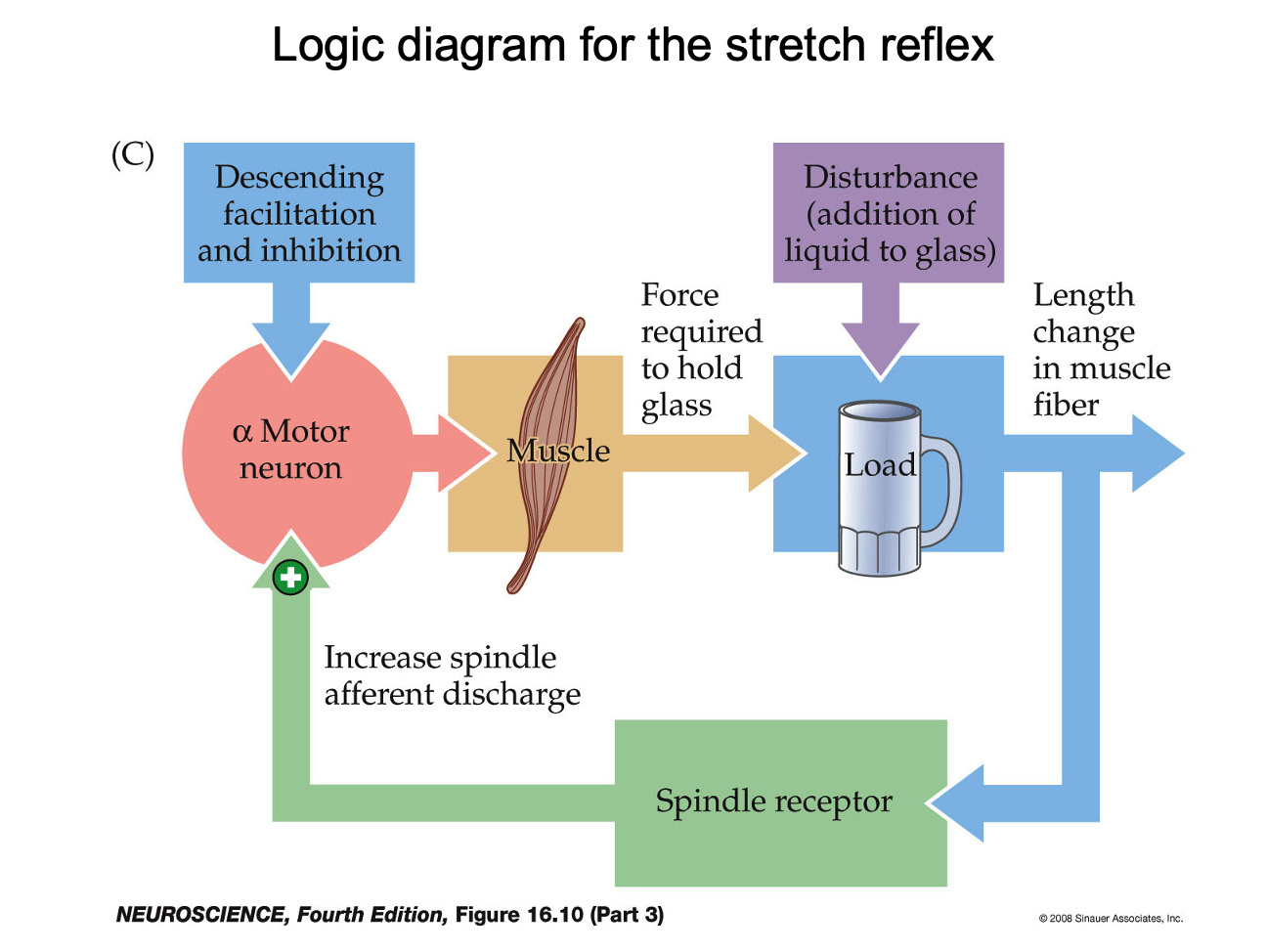
The stretch reflex is also important for maintaining posture.
For example, if you are standing up and start to tip backwards, the extensor muscles in the front of your leg will be stretched, activating the stretch reflex for those muscles, which will lead to __________ of the stretched muscles, helping to restore upright posture.
rapid contraction
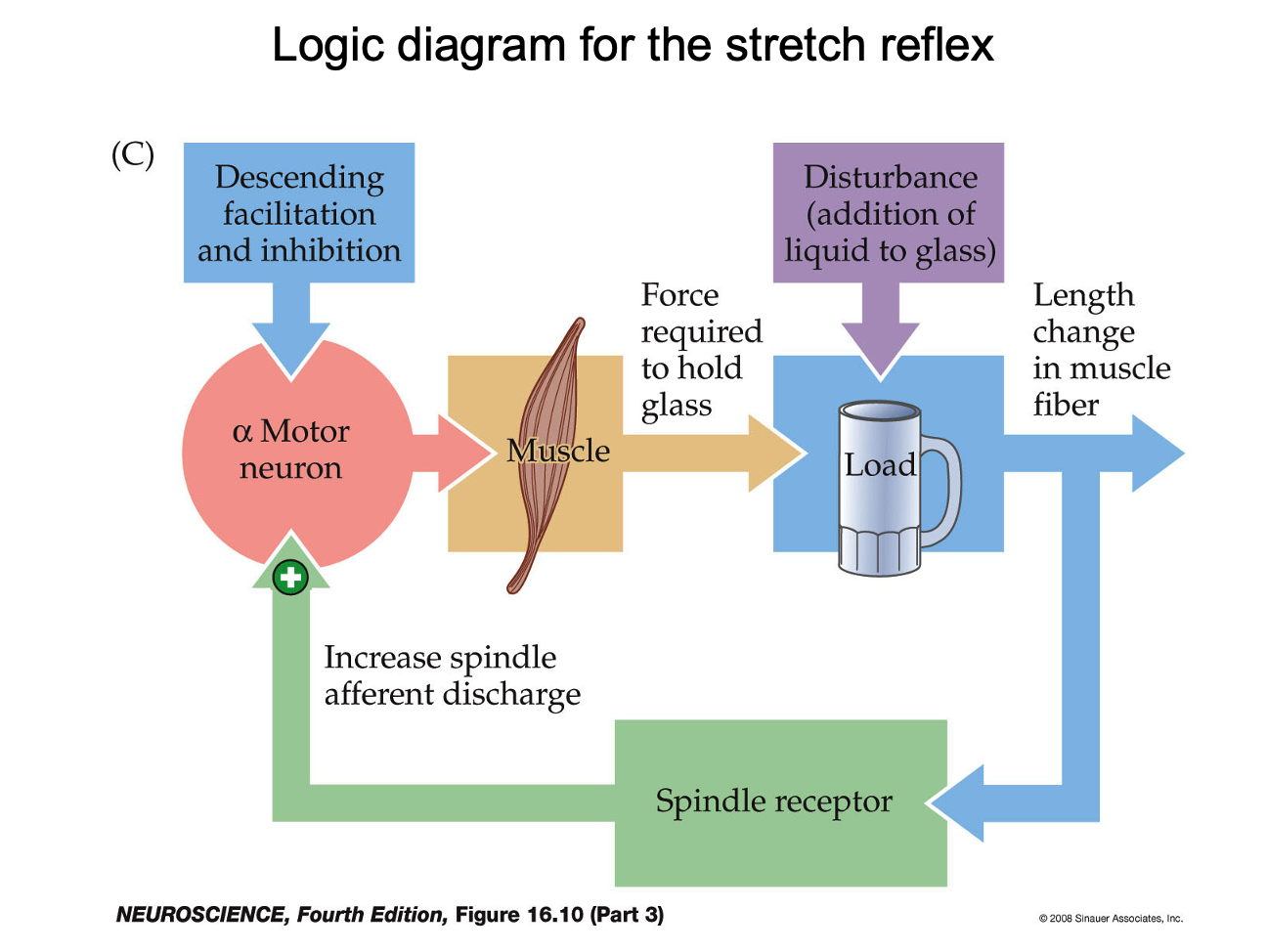
In summary, the myotatic reflex comprises:
activation of Ia and II afferents which then produce:
monosynaptic activation of α-motor neurons to the (homonymous) muscle that is stretched
polysynaptic facilitation of α-motor neurons to agonist muscles
polysynaptic inhibition of antagonist muscles
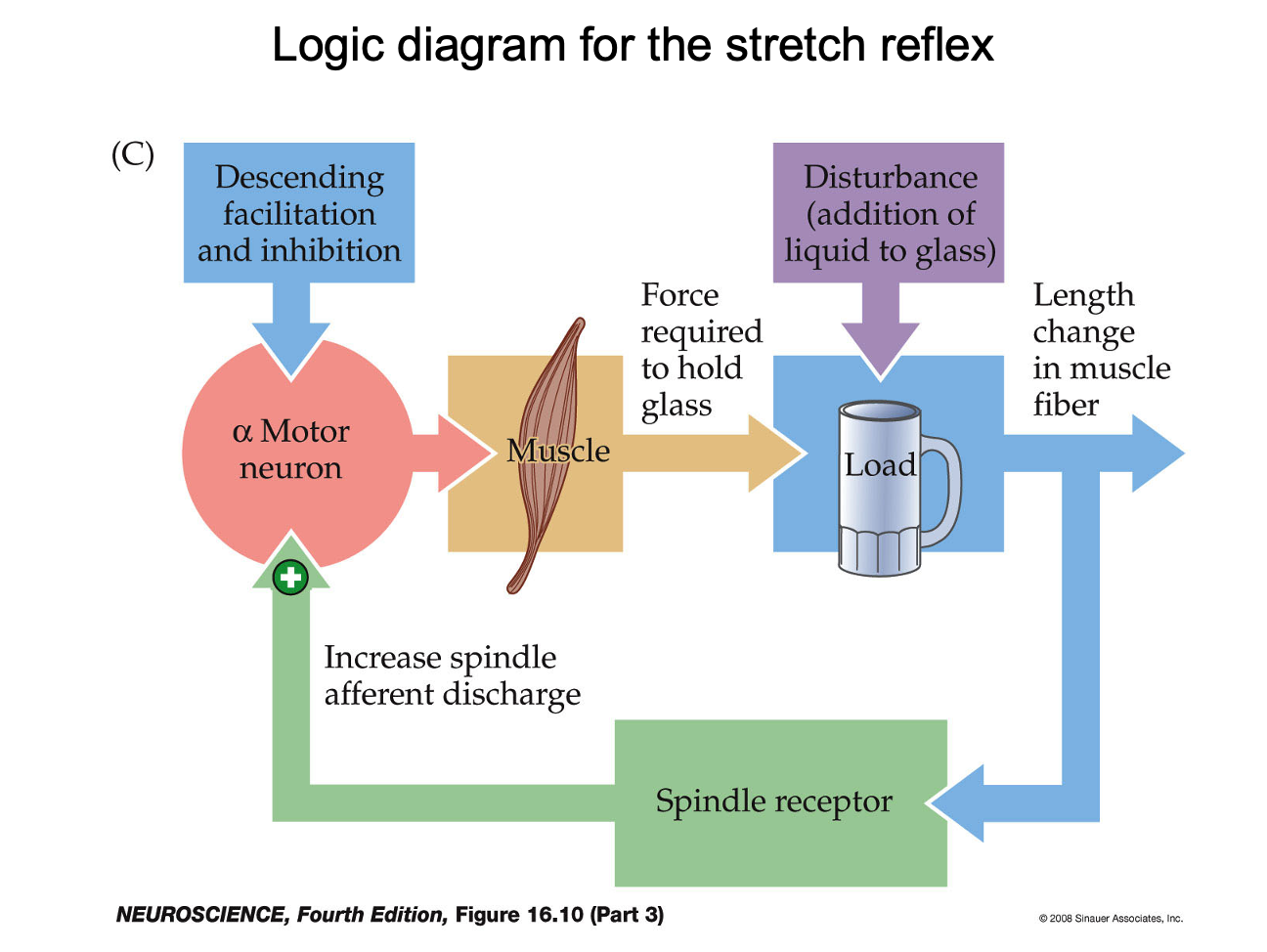
Review logic diagram!
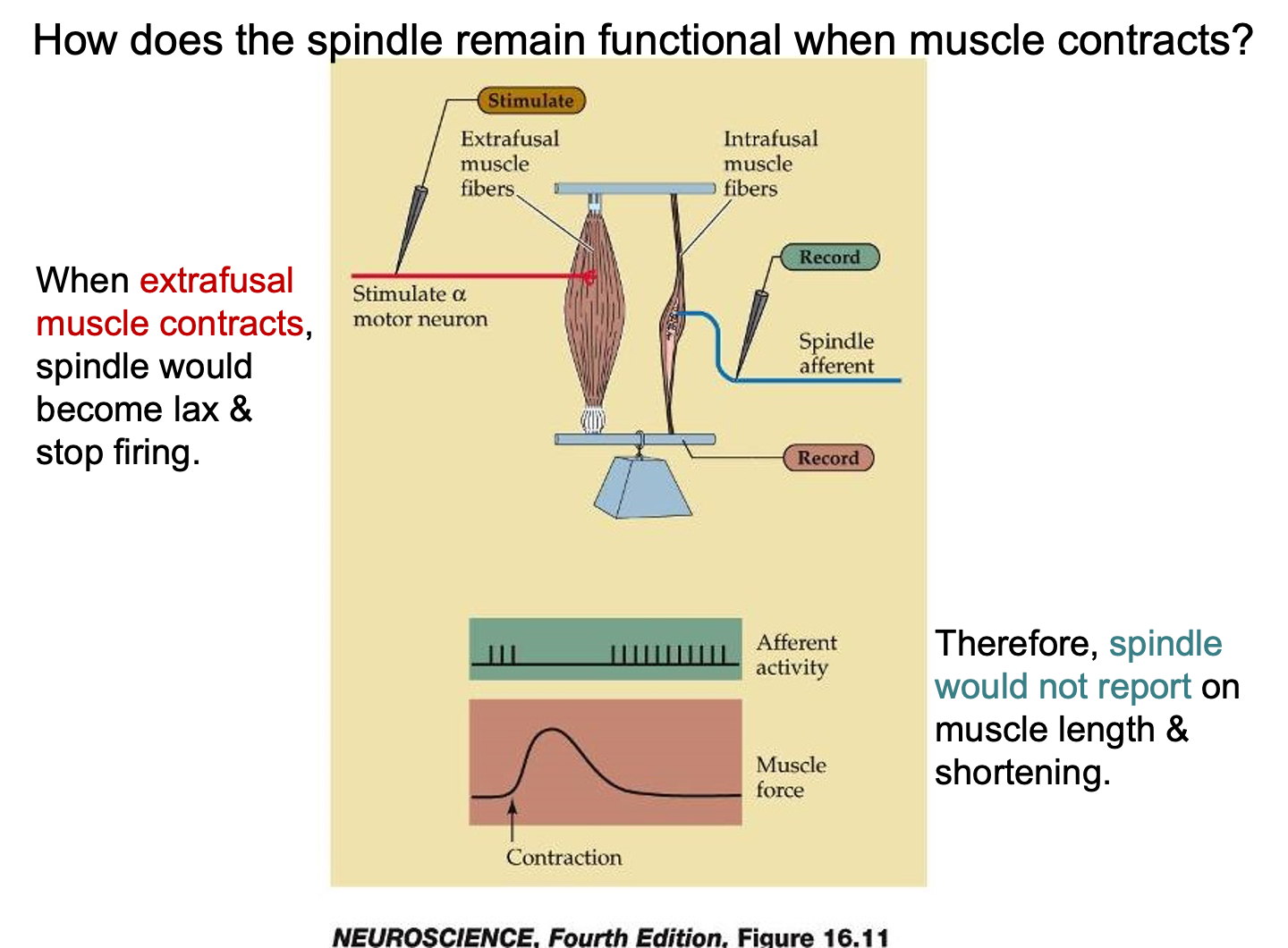
Consider now what would happen if the extrafusal fibers undergo an ________ and shorten.
The spindle would become slack (“unloaded”) and the stretch receptors would _________ either length or change of length.
Instead, sensitivity is preserved by adjusting the _______ of the muscle spindle organ to match the muscle as a whole.
This adjustment is achieved through the action of __________.
isotonic contraction
no longer signal
length
small γ-motor neurons
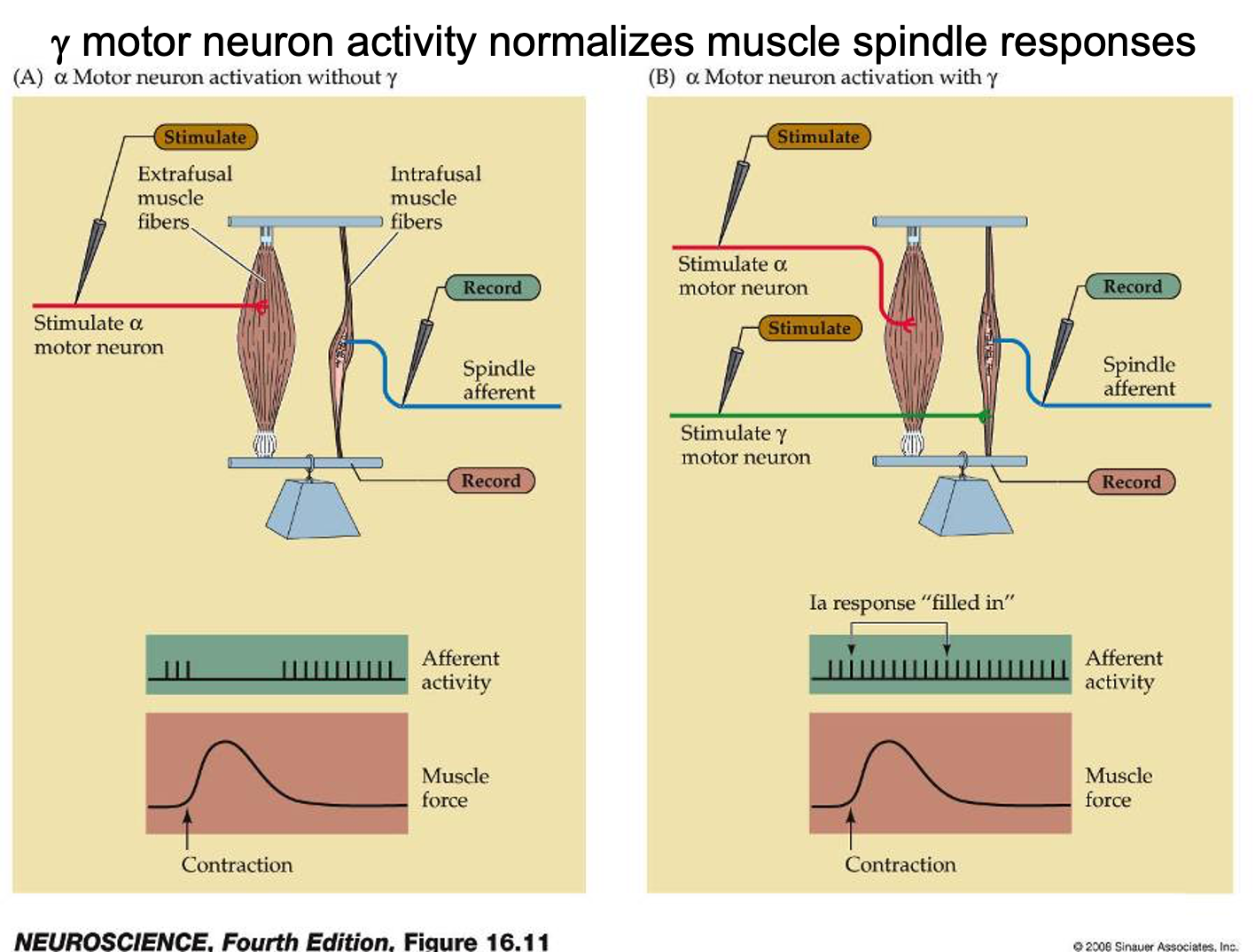
The cell bodies of γ-motor neurons are interspersed among α-motor neurons in the ______ horn. Their axons are ________________.
ventral
small diameter and myelinated
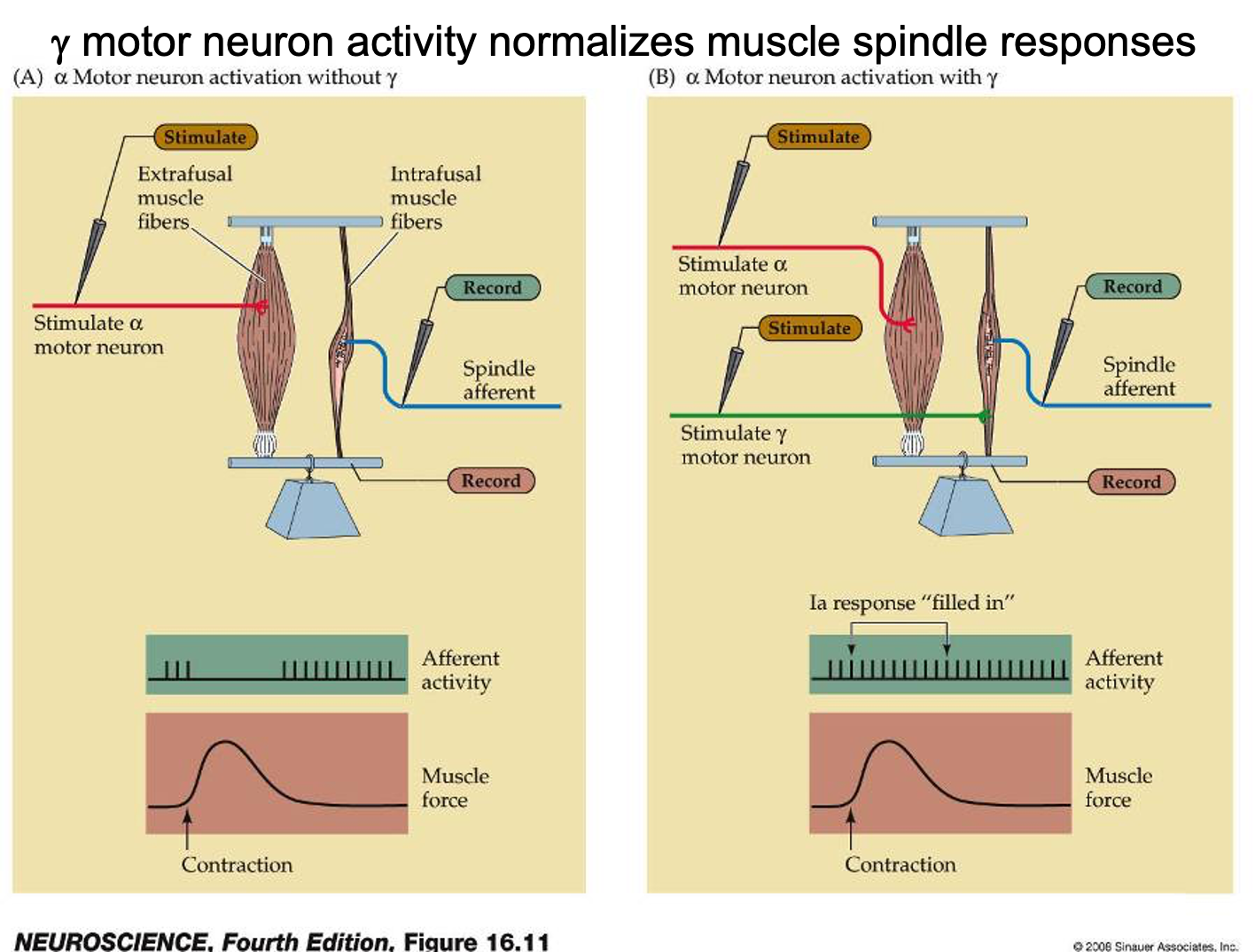
Discharge of γ-motor neurons triggers contraction of the poles of _______ myofibers. This shortening keeps the spindle taut, allowing it to continue ________ fine changes in muscle length over the entire functional range of the muscle.
intrafusal
signaling
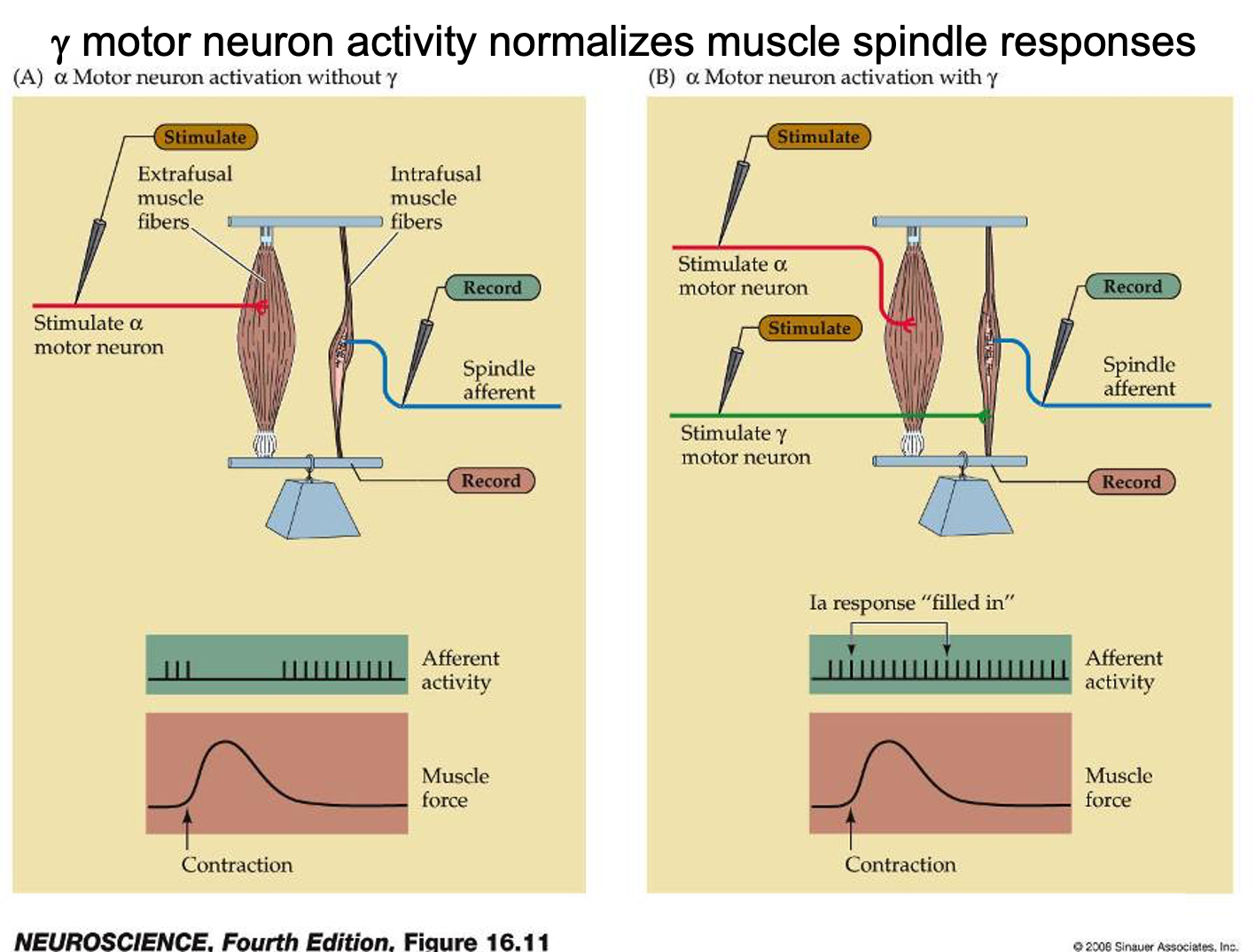
In most natural movements, the γ-motor neurons drive the spindle fibers to contract __________ with α-motor neurons driving the bulk muscle to contract.
As a consequence, the spindle organ and bulk muscle _______ synchronously, keeping the sensory endings of the spindle organ sensitive throughout the muscle contraction.
simultaneously
shorten

γ motor neuron activity normalizes muscle spindle responses
As a consequence, the spindle organ and bulk muscle shorten synchronously, keeping the sensory endings of the spindle organ sensitive throughout the muscle contraction.
Thus, the group 1A and II axons can still ______________ of muscle length/velocity to correct the motor action on the muscle.
signal any perturbations
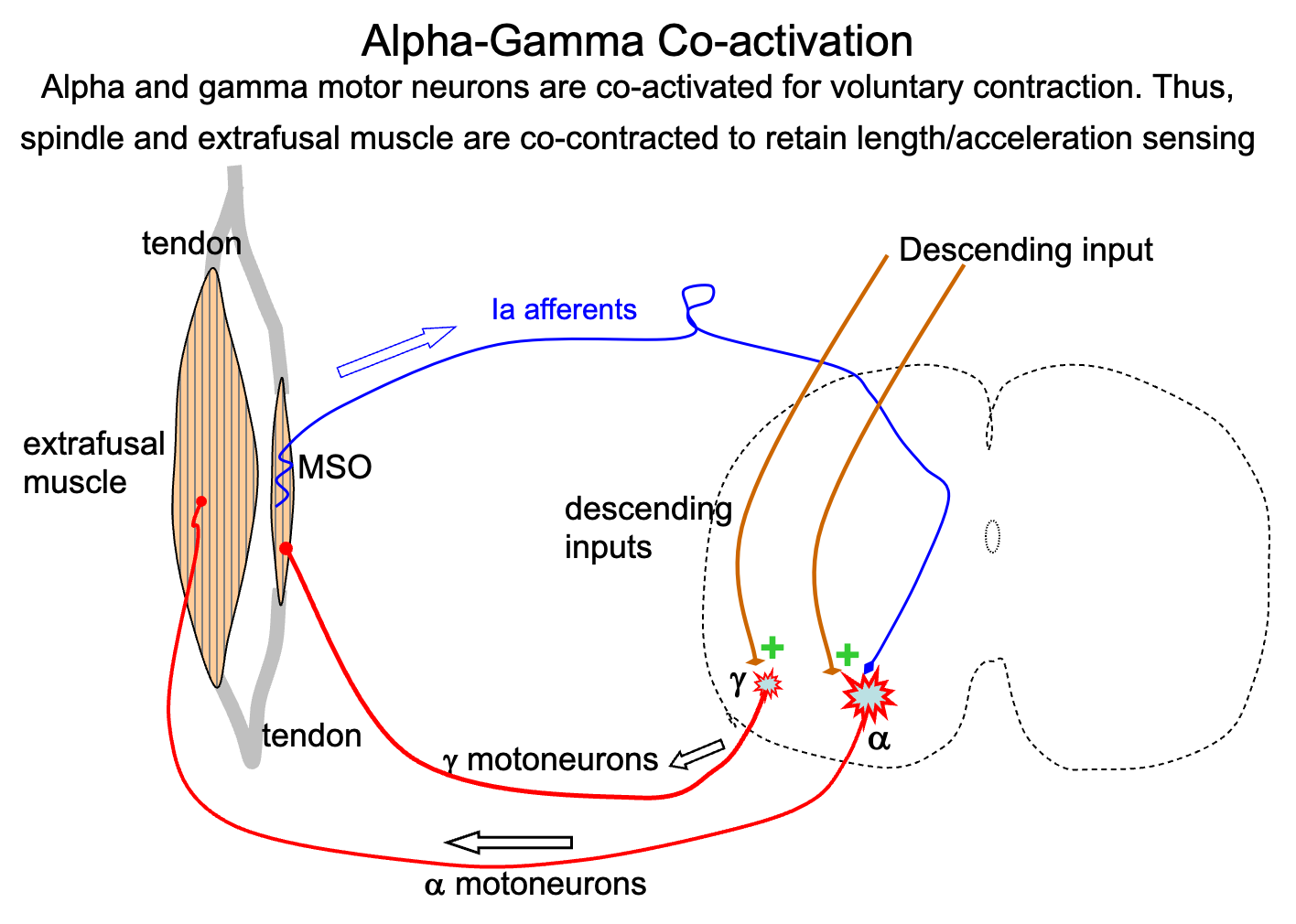
Most voluntary movements, initiated by activity from higher motor centers (e.g. motor cortex), include __________ activation of both γ- and α-motor neurons.
The α-motor neurons activate the _______ muscle fibers to produce force, while the γ-motor neurons activate the ___________ of the spindle to set a desired length.
simultaneous
extrafusal
contractile poles
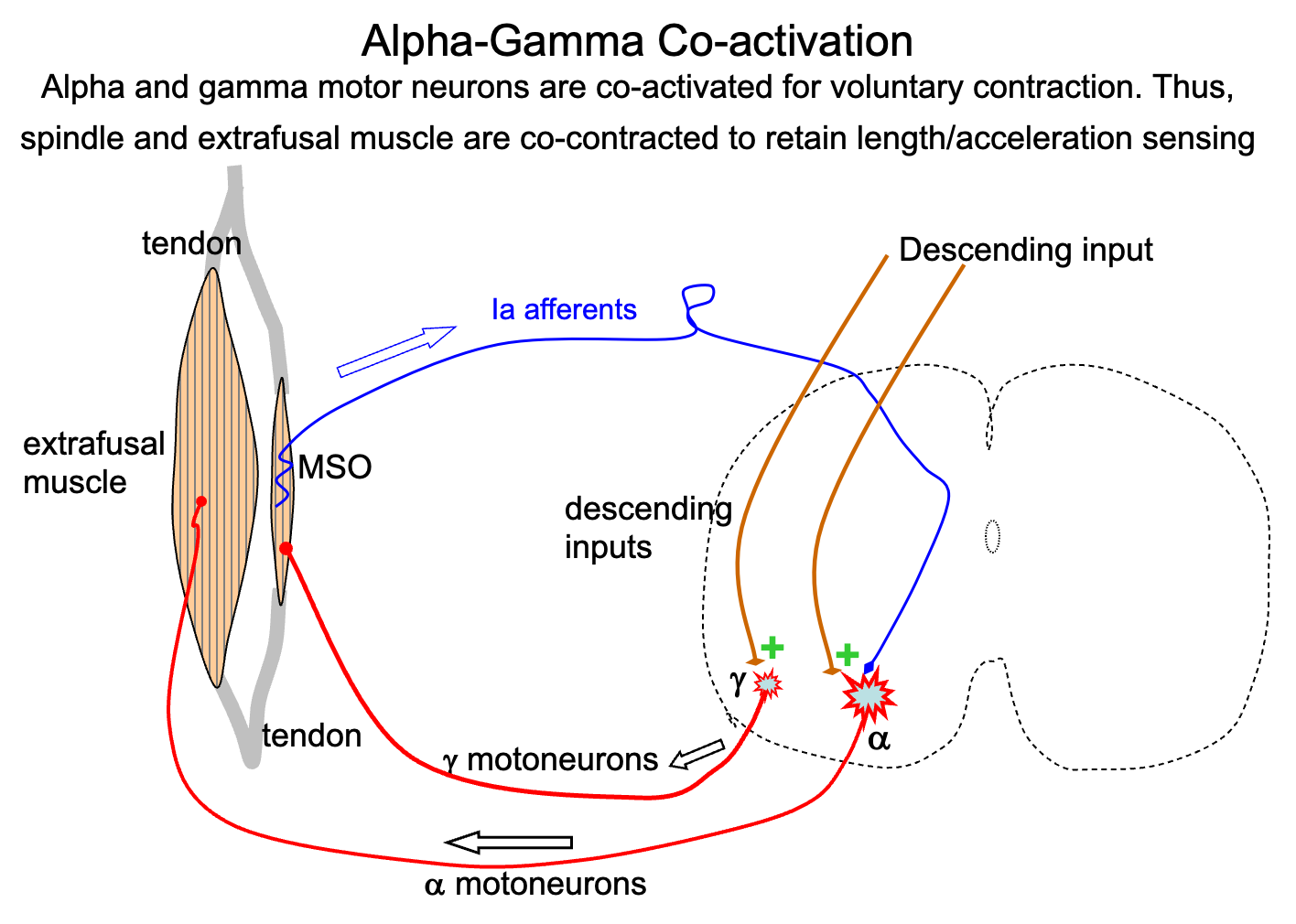
Alpha-gamma co-activation keeps the spindle sensitive, and able to provide ___________ on muscle length and deviations from the intended position or muscle length.
sensory feedback
Consider the voluntary action of holding a cup at a specified position. Once the movement has been completed, the various muscles continue to contract enough to maintain position. But if the load (the weight of the cup) changes, how would appropriate adjustments be made to adjust muscle tension to bring the limb back to correct position?
Both the muscle spindle afferents and γ-motor neurons are involved in this correction.
Higher motor centers have already set the α- and γ-motor neuron firing rates so that the extrafusal and intrafusal fibers are at the intended length and position.
Now, the increased load has stretched both the muscle and the spindle. The latter causes the group IA and II afferents to fire rapidly.
This in turn activates the α-motor neurons further, and muscle contraction increases until the muscle is back to the pre-set length (and hence the cup is back to the correct position).
Consider the voluntary action of holding a cup at a specified position.
Conversely, if the load became lighter, the same contraction of the ________ muscle would shorten the muscle, reducing the stretch of the spindle. This would result in ________ activity in the spindle afferents and hence, would reduce the drive on α-motor neurons. Thus, the output of the muscle spindle organ receptors acts as an _________ that helps the motor system achieve a controlled and precise movement.
extrafusal
decreased
error signal
__________ refers to the functional circuit that includes spindle afferents, α- and γ-motor neurons, and coordinately regulates the contraction of extrafusal and intrafusal muscle fibers.
Gamma loop
Gamma loop serves as a ____________ to regulate the accuracy of a voluntary contraction.
feedback loop
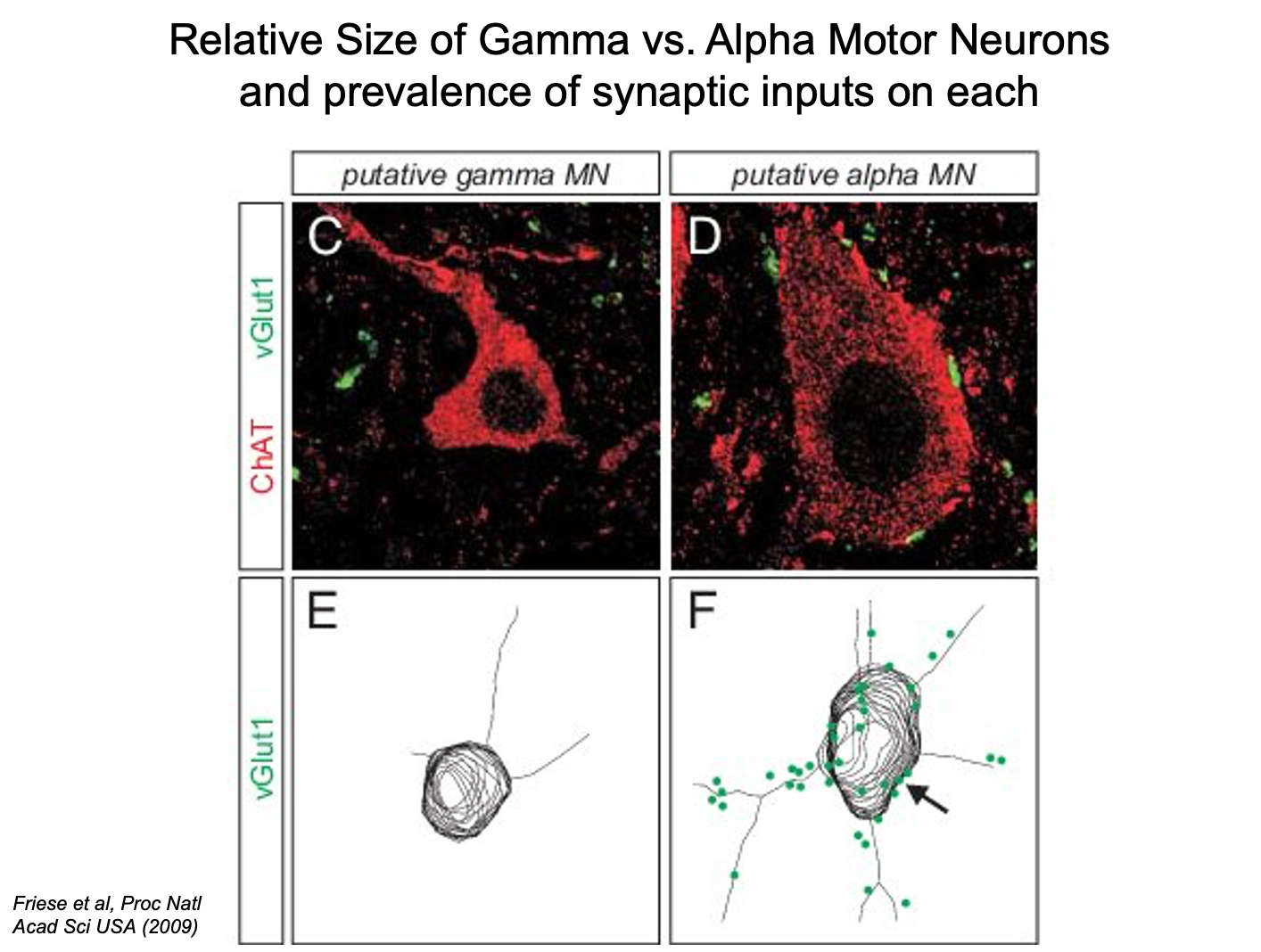
*Review
Relative Size of Gamma vs. Alpha Motor Neurons and prevalence of synaptic inputs on each
______ muscle tone (low level contraction while at rest) is determined by the resting output of static γ-motor neurons.
During some stages of _________, γ-motor neurons are less active and so muscles become more flaccid.
Normal
normal sleep
Muscle tone:
In healthy individuals, the skeletal muscles are seldom in a fully relaxed state.
Muscle tone is the tension (slight contraction) present in resting muscle.
Tone can be also assessed as resistance to passive movement.
Tone is caused by low baseline activity in ___________. This low activity then creates a steady, low level of α-motor neuron activation and low-grade muscle tension via the ______ reflex. Muscle tone depends primarily on _____ spindle afferents.
spindle afferents
stretch
static
_____ is used as an indicator of intact spinal reflexes and descending motor controls.
Tone
_______ is a condition in which there is exaggerated muscle tone, resulting in joints that are stiff or even immobilized.
This may result from _______ stretch reflex or from _______ in descending control.
Hypertonia
overactive
imbalance
____________ is seen following stroke or certain neurodegenerative conditions.
Hypertonicity
_________ is defined by a velocity-dependent increase in muscle tone. That is, the faster the muscle is moved or stretched, the greater the resistance to stretch.
Spasticity
Spasticity typically results when __________ are lost or disconnected from spinal circuits.
Disinhibition of the dynamic 1a spindle afferents leads to exaggerated motor neuron activation, and contraction of the whole ___________.
upper motor neurons
extrafusal muscle
________ may result from stroke, traumatic injury or neurodegenerative diseases.
Spasticity
Excessive resting discharge of ___________ produces high resting muscle tone (i.e. rigidity) and/or exaggerated stretch reflexes.
Hyper-reflexia and spasticity can arise via several other mechanisms as well.
Spinal cord injury appears to give rise to ________ membrane excitability of motor neurons themselves.
In some instances, the axons of 1A afferents may undergo ________, giving rise to excess excitatory input onto α-motor neurons.
γ-motor neurons
increased
sprouting
The above spinal reflexes (stretch) are involuntary. But they can be modulated under many circumstances. For instance, the gain or strength of the motor output (e.g. extension of limb) may be damped if the person is aware of an obstacle in the path. This modulation occurs through the action of ________________________.
descending inputs onto inhibitory interneurons
RECEPTORS: __________: a sensor for muscle force
Golgi Tendon Organ
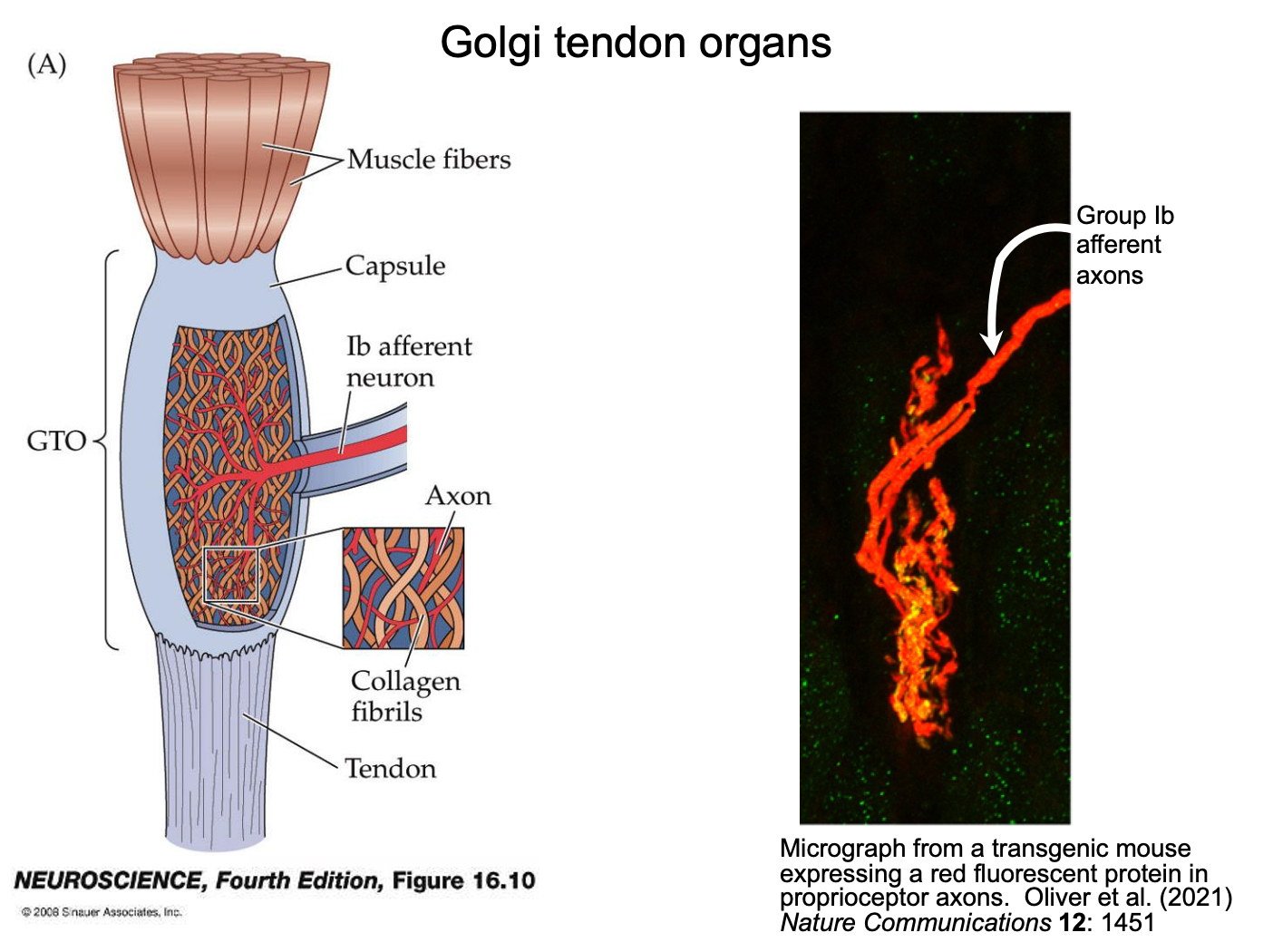
Golgi tendon organs provide information about the _____ generated by the muscle.
force
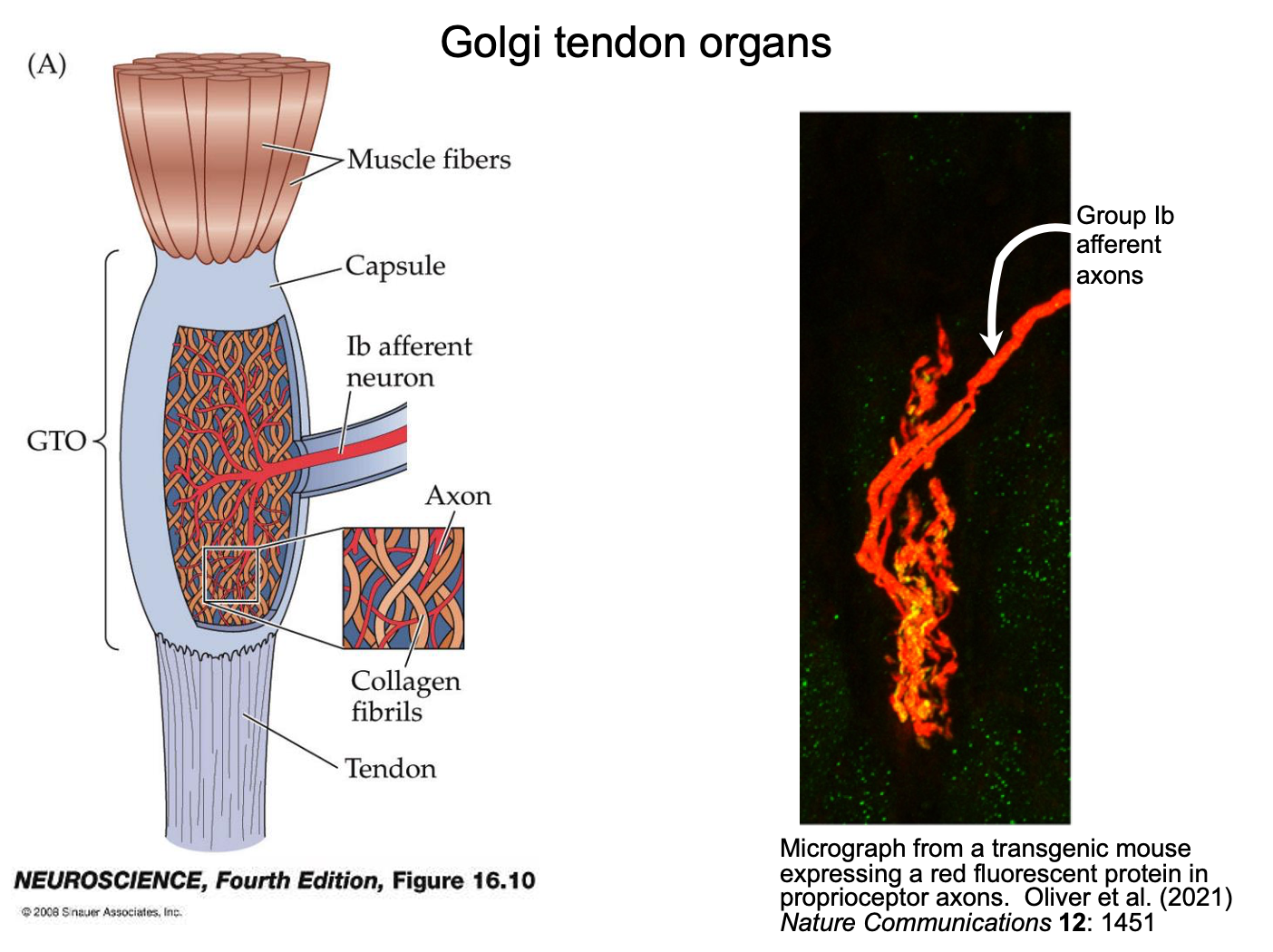
Golgi tendon organs are located in the _______ at the ends of muscle fascicles. Muscles are composed of many such fascicles, with the corresponding small tendons either ______ into larger tendons or ______ separately.
small tendons
converging
inserting
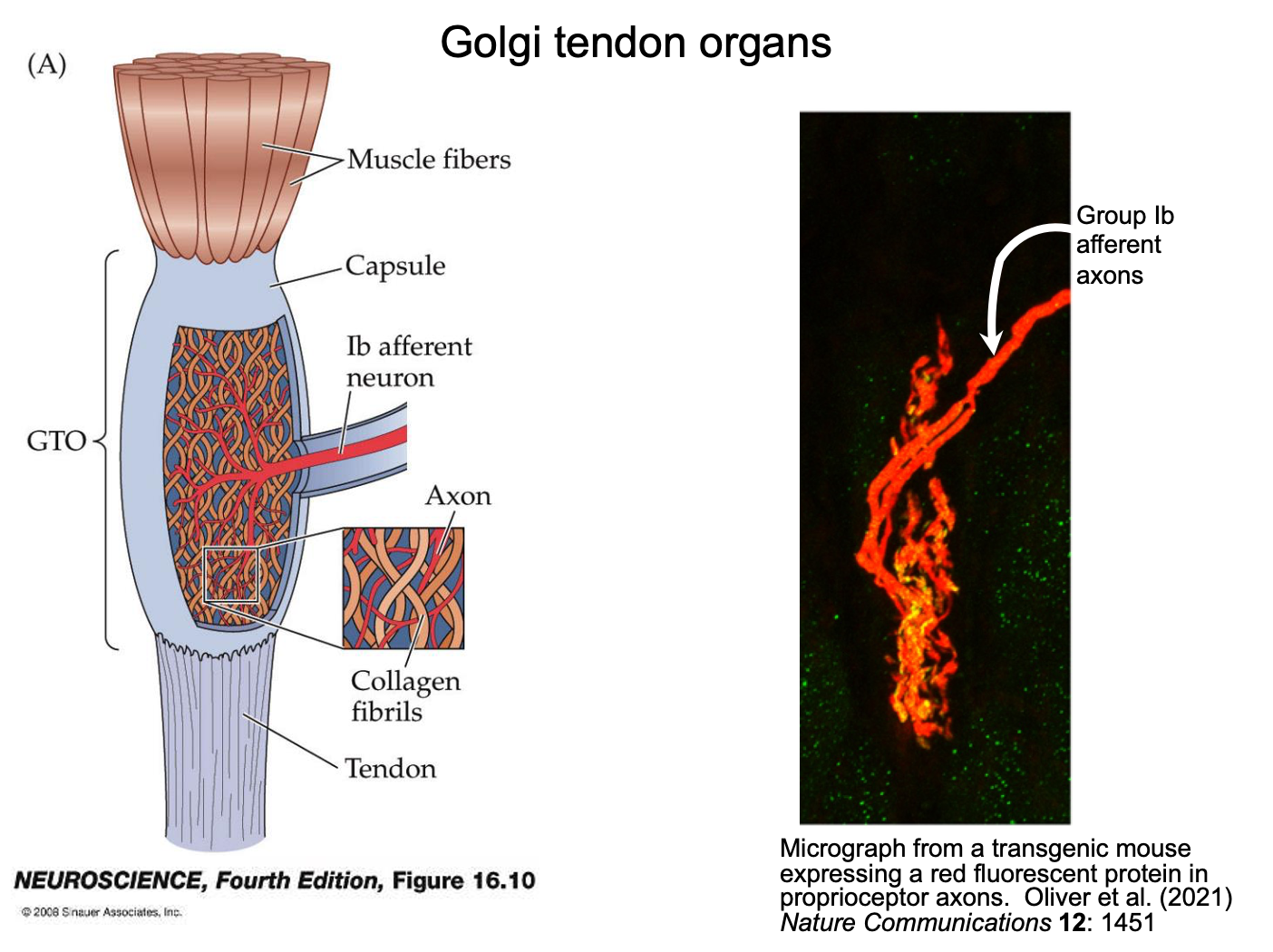
Afferent sensory information from the Golgi tendon organs is conveyed to the spinal cord via _________, rapidly conducting (about 100 meters/sec) myelinated axons. Unlike the spindle organ, there is no ________ innervation to the Golgi tendon organ.
large diameter (Group IB)
efferent
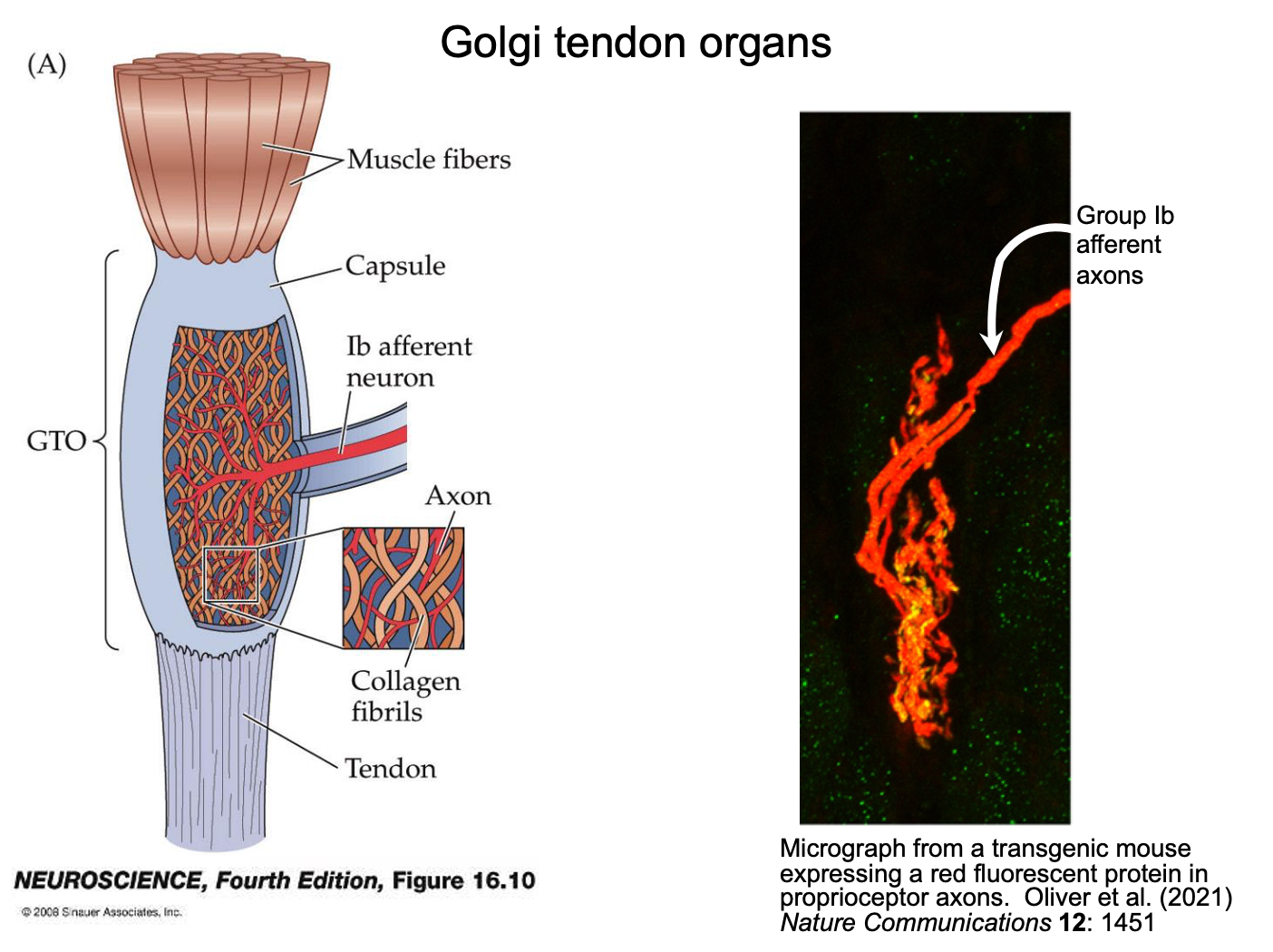
A given Golgi tendon organ is in ______ with the muscle fibers in its fascicle. Thus, it directly senses the ______ generated by those muscle fibers.
series
tension
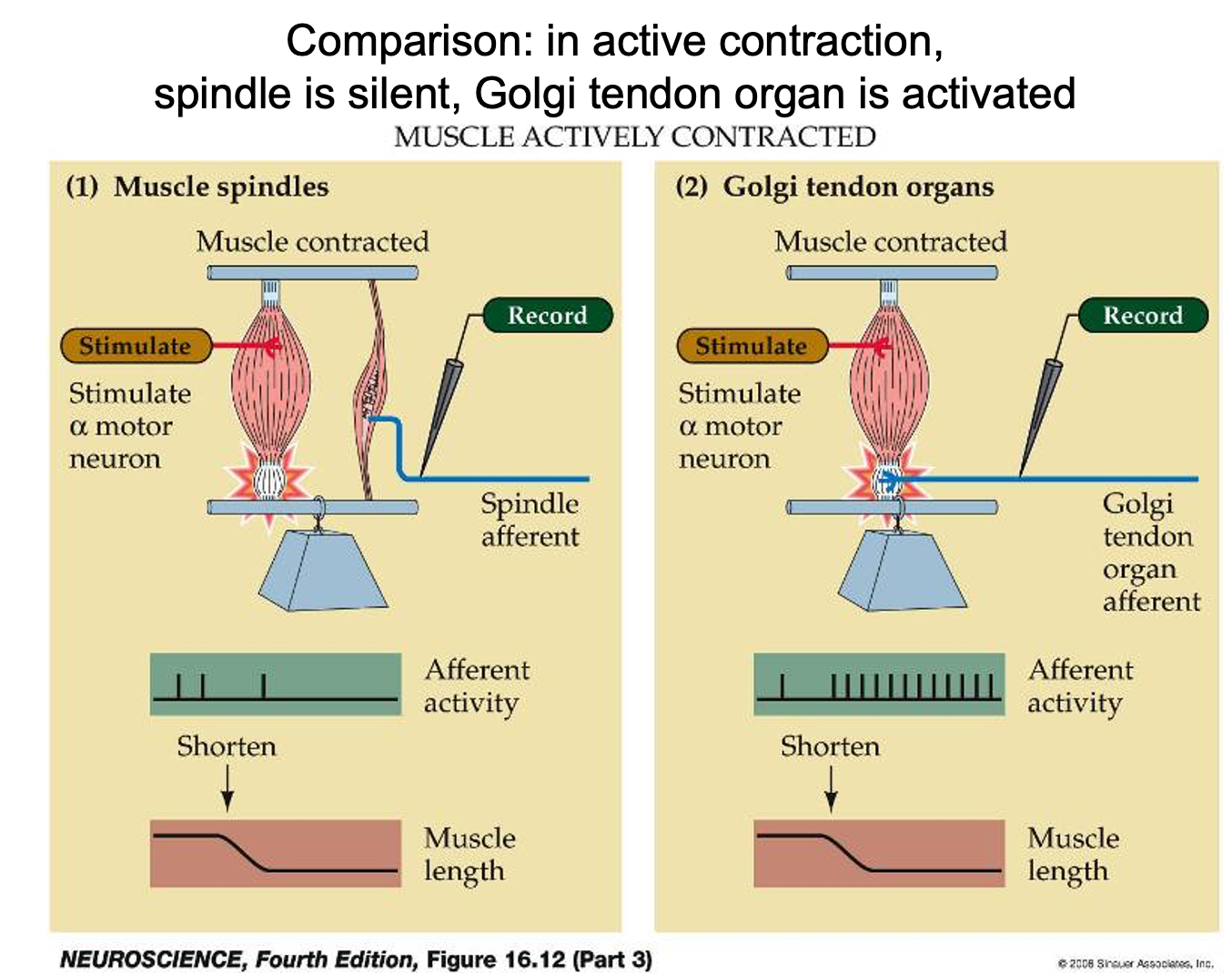
Golgi tendon organs are most sensitive to active tension produced by contraction of muscle fibers _____ its particular muscle fascicle (right image).
Contraction of even a single motor unit within its muscle fascicle produces ______________.
within
measurable activity in the afferents
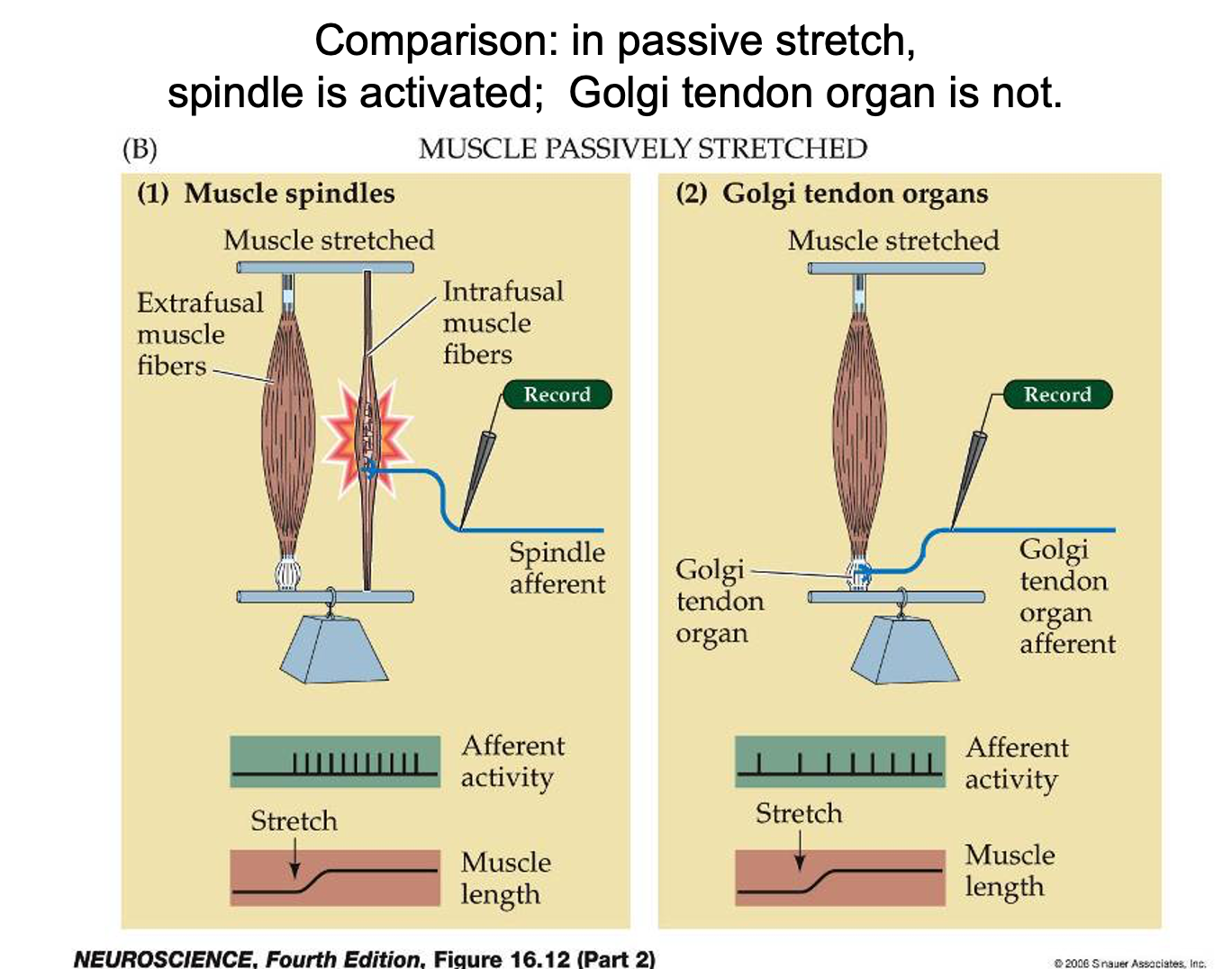
Although Golgi tendon organs are very sensitive to active muscle contraction, they are _________ by an externally applied i.e. passive stretch (right image).
This is because the muscle itself is more ______ than the tendon, and also because the passive stretch is distributed over ___ the small fascicle tendons.
poorly activated
elastic
all
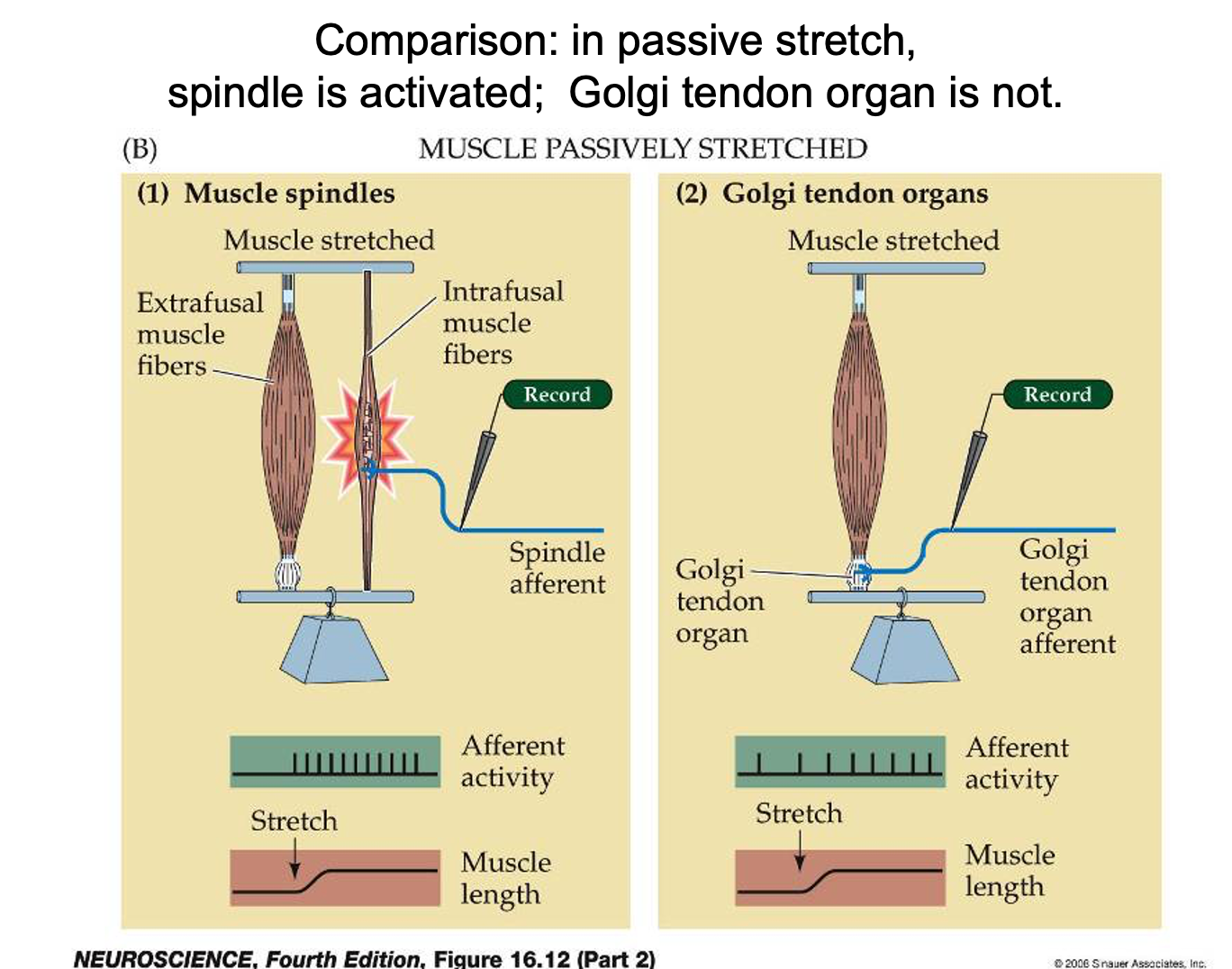
________ afferent fibers that innervate the Golgi tendon organ are activated when the muscle contracts.
As with all somatosensory neurons, their somata are located in the _____________.
The central terminals of these afferent fibers make excitatory synapses on inhibitory interneurons located in the ___________ of the dorsal horn.
These interneurons in turn synapse onto the __________ of the homonymous muscle, releasing _______, an inhibitory transmitter, when activated.
Thus, activity of the Golgi tendon organ receptors _________ the motor neurons controlling the same muscle.
Group IB
Dorsal Root Ganglia
lower portion (lamina IV)
α-motor neurons
glycine
autogenically inhibits
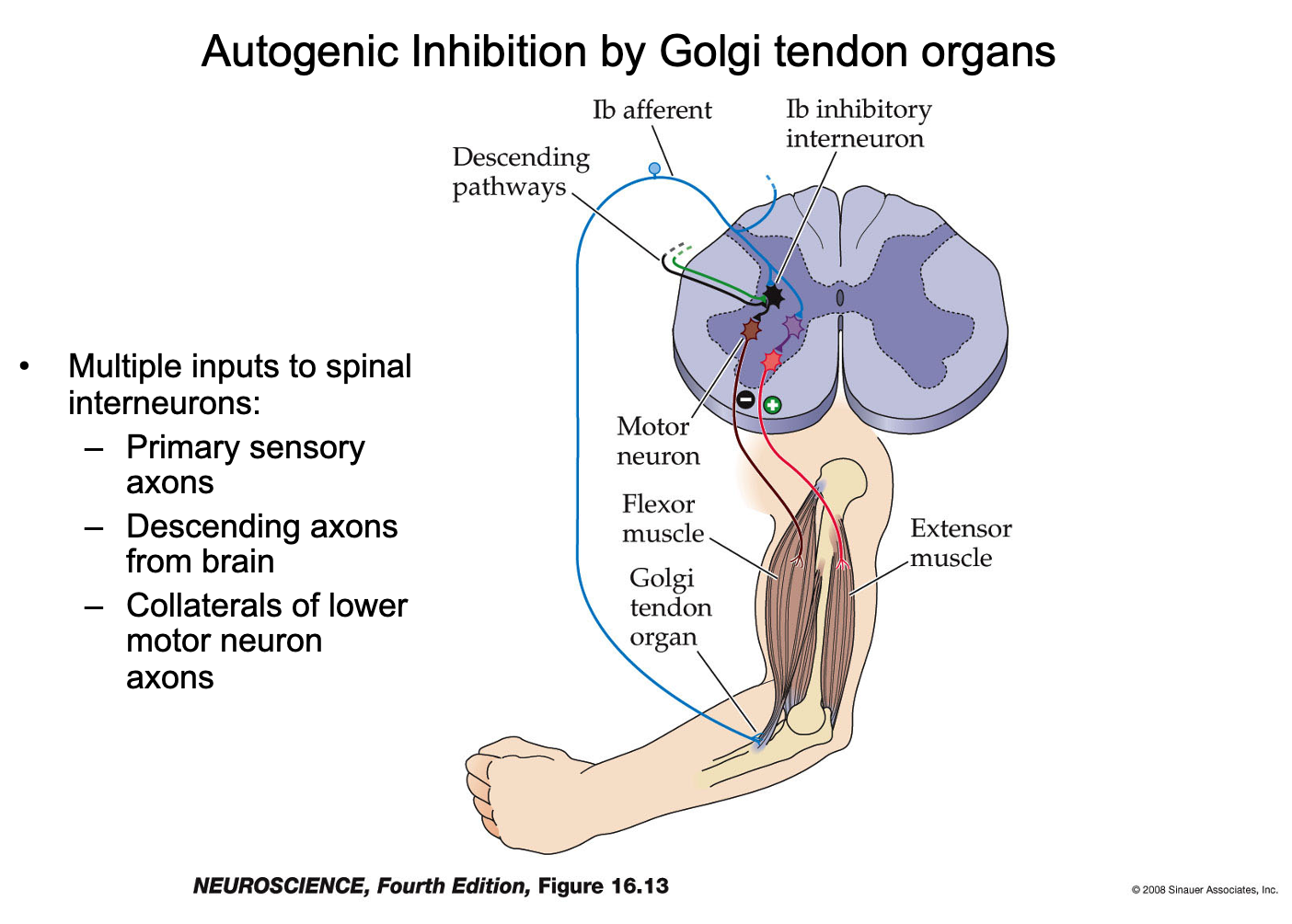
Minor branches of afferent fibers from Golgi tendon organs also make ________ synapses onto other interneurons which excite motor neurons innervating antagonist muscles.
That is, the reflex circuits from the Golgi tendon organ receptors are almost exactly ________ to those from the annulospiral receptors of the muscle spindle organ.
weak excitatory
opposite
Autogenic Inhibition by Golgi tendon organs
Multiple inputs to spinal interneurons:
Primary sensory axons
Descending axons from brain
Collaterals of lower motor neuron axons
The primary role of the Golgi tendon organs is to provide the sensory feedback necessary for accurate control of __________, particularly during a prolonged contraction.
The Golgi tendon organ feedback may also improve the mechanical efficiency of the muscle by _____________ across all fascicles.
By damping groups of motor units that are over-contracting relative to other fascicles, tendon organs would help to ensure ___________ across the muscle.
muscle tension
distributing the contraction evenly
even production of force
Tendon organs are stimulated by _____________.
both weak and strong active contraction
Tendon organs are distributed throughout the tendons at the ____ of muscle fascicles (clusters of myofibers), and report on tension produced in each fascicle.
The total 1b signal is an estimate of __________.
ends
total muscle force
Physiological roles of Golgi tendon organs:
____________ may help to spread load across all the fascicles of a muscle - by reducing tension in any fascicle that is contracting more strongly than the rest.
Autogenic inhibition
Physiological roles of Golgi tendon organs:
Conversely, tendon organs in multiple fascicle tendons can represent _______________ across fascicles of a muscle, e.g. for an intended rotational movement.
the spatial distribution of tension
Golgi tendon organs contribute to ___________, including the sense of force and load.
Normally, information from Golgi tendon afferents is combined with information from spindle afferents for __________ of motor output.
proprioception
integrated adjustment
______ is involuntary rhythmic contractions in response to sudden sustained stretch.
Clonus
Clonus is produced by alternating cycles (3-10 /sec) of flexor and extensor muscles being activated, reflecting damage to ________________.
upper motor neurons and descending control
Clonus may also arise from a ____________, and often occurs with spasticity.
hyperactive stretch reflex
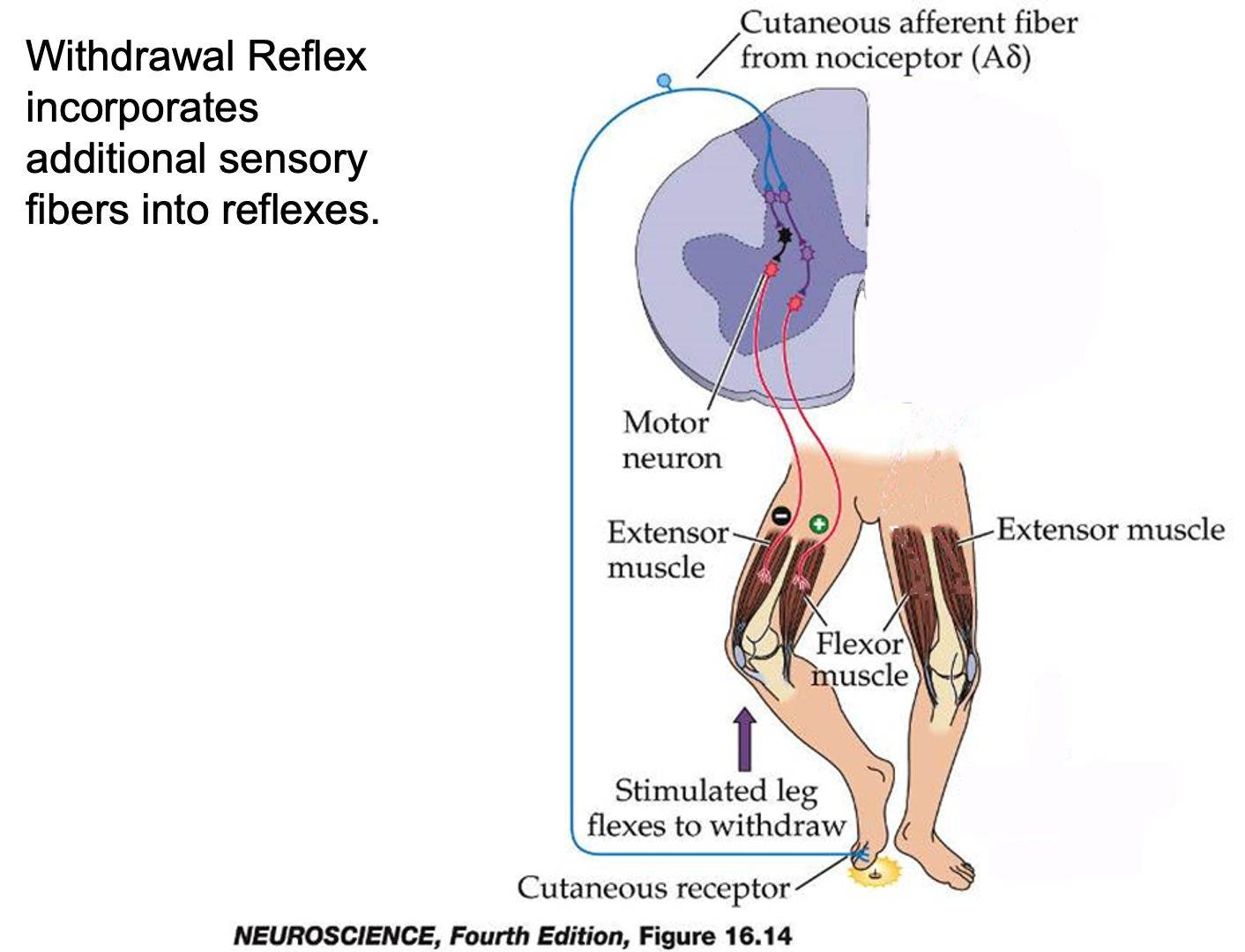
When a painful (nociceptive) stimulus is applied to the skin, a person ___________ from the painful stimulus.
This reflex is not as fast as the stretch reflex described above, but the initial portion of the response still occurs _______ the higher brain centers could produce the protective movement intentionally.
quickly pulls away
before
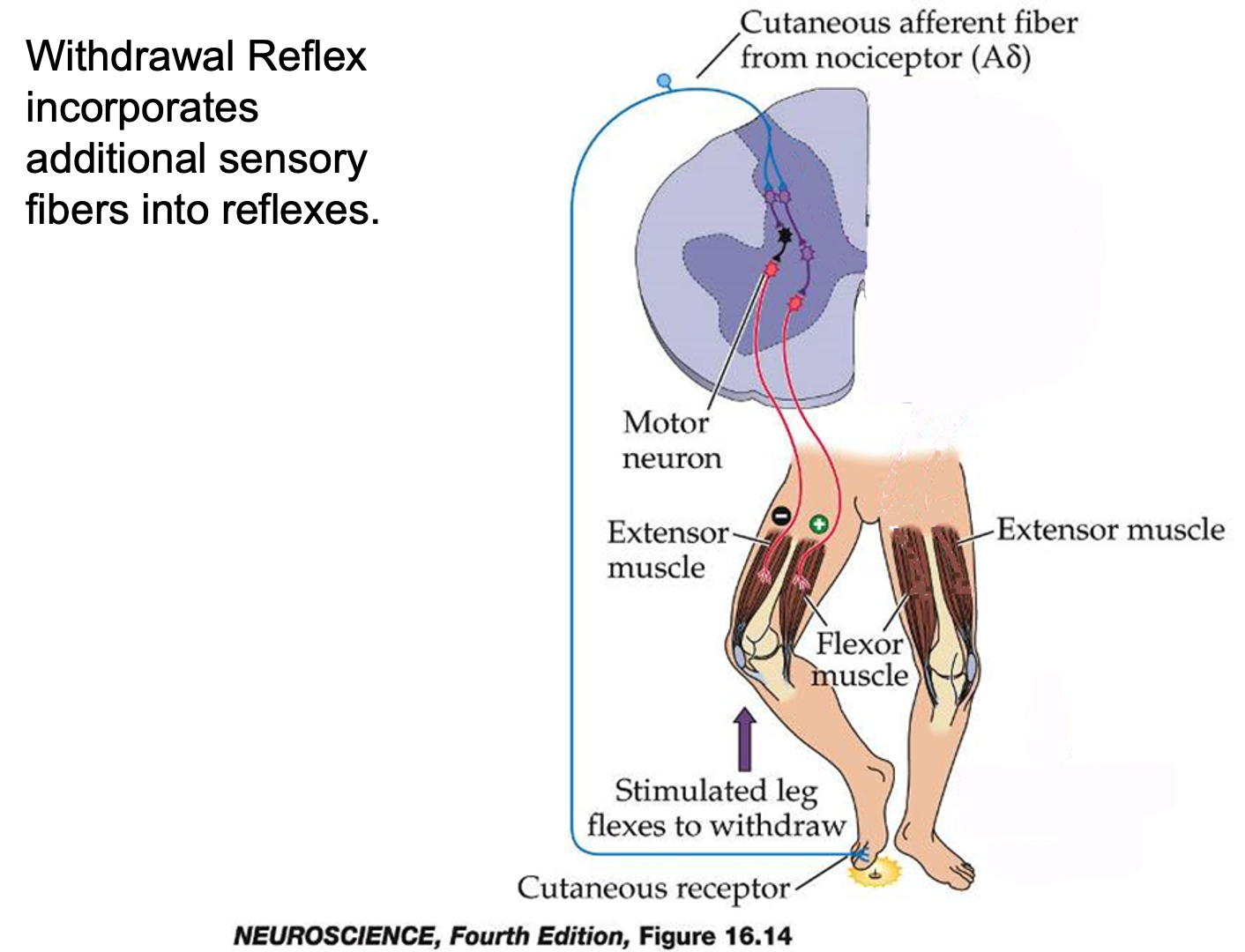
The withdrawal reflex is initiated when a painful stimulus initiates an increased discharge in ____________ primary afferent fibers connected to pain receptors.
This is a __________ reflex, since several sets of spinal interneurons intervene before the message to contract reaches the appropriate motor neurons.
group III and C type
polysynaptic
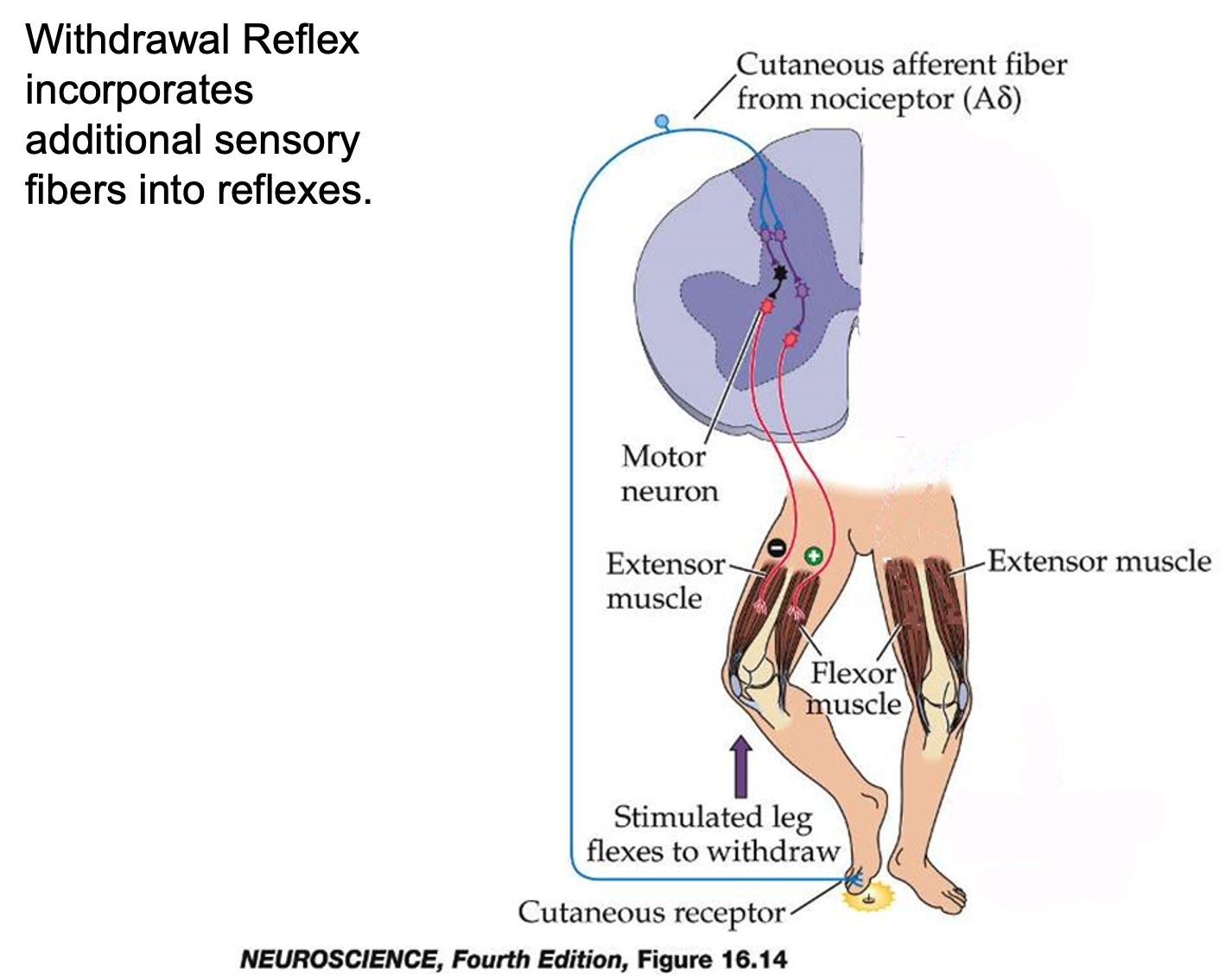
This nociceptive withdrawal reflex is also called the __________, since the withdrawal response usually involves flexion to pull away from the painful stimulus.
But the particular withdrawal movement depends on the _______ of the painful stimulus; the reflex movement will produce ______ of a limb if that is appropriate to get away from a particular painful stimulus.
flexion reflex
location
extension
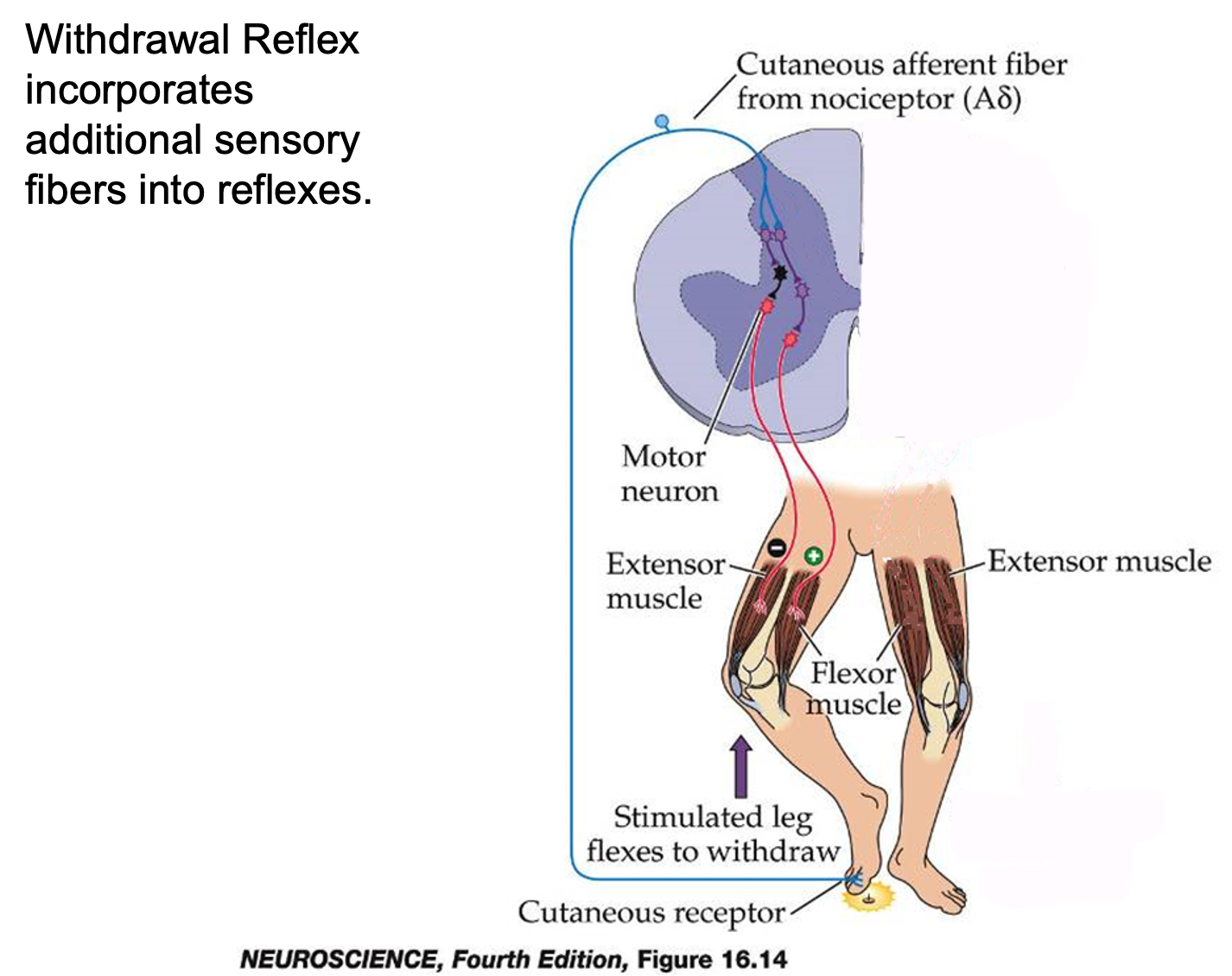
This variation of the reflex movement depending on the location of the painful stimulus is called __________.
"local sign"
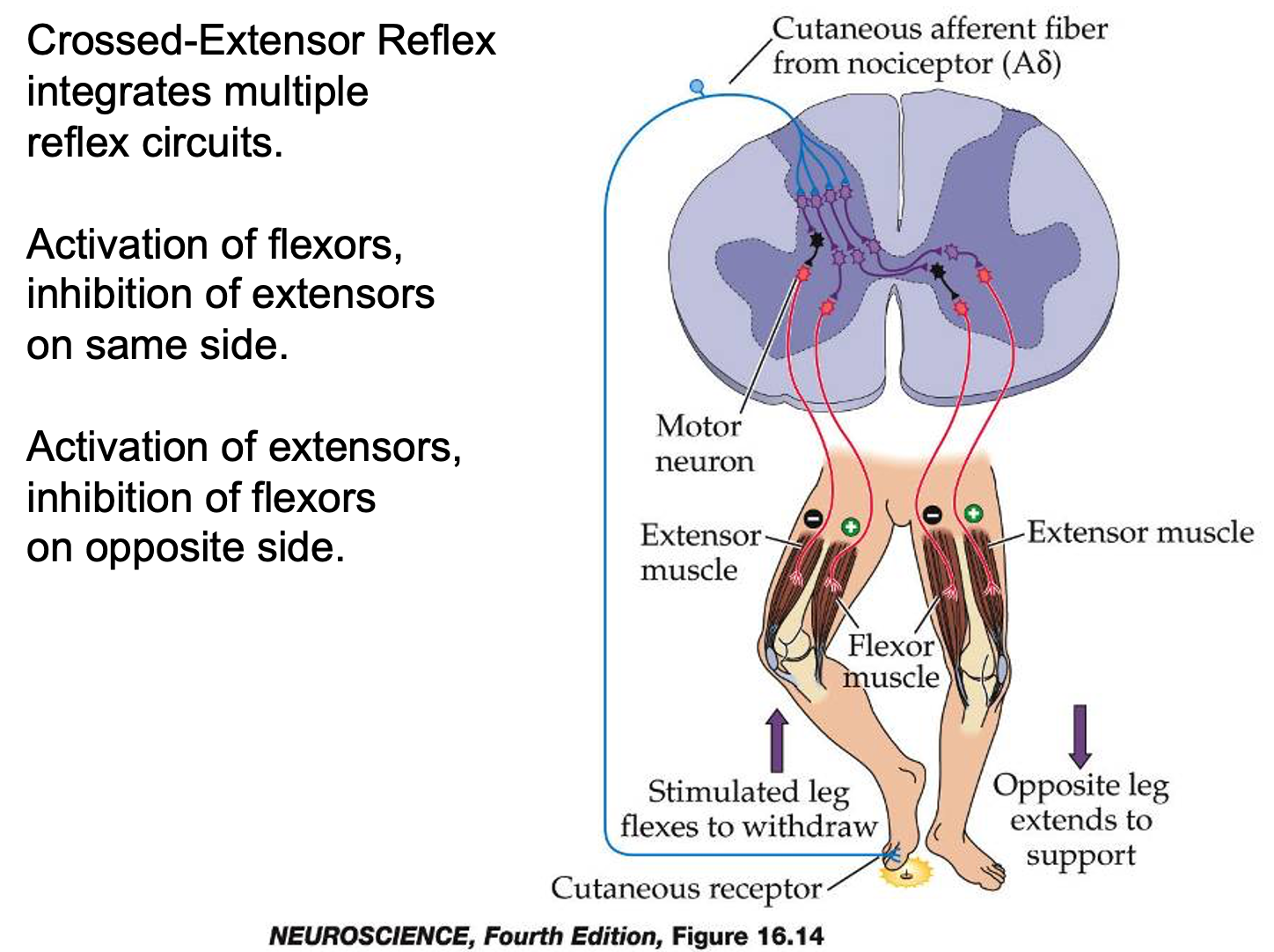
Branches of interneuron axons also _____ the spinal cord midline, and synapse with additional interneurons to activate flexors and extensors _______________.
That is, if the flexion reflex caused contraction of the flexor muscle on the right, then the flexor muscle on the left would _______.
This is achieved through the involvement of opposing _______________.
cross
inversely to the originating side
relax
excitatory and inhibitory interneurons
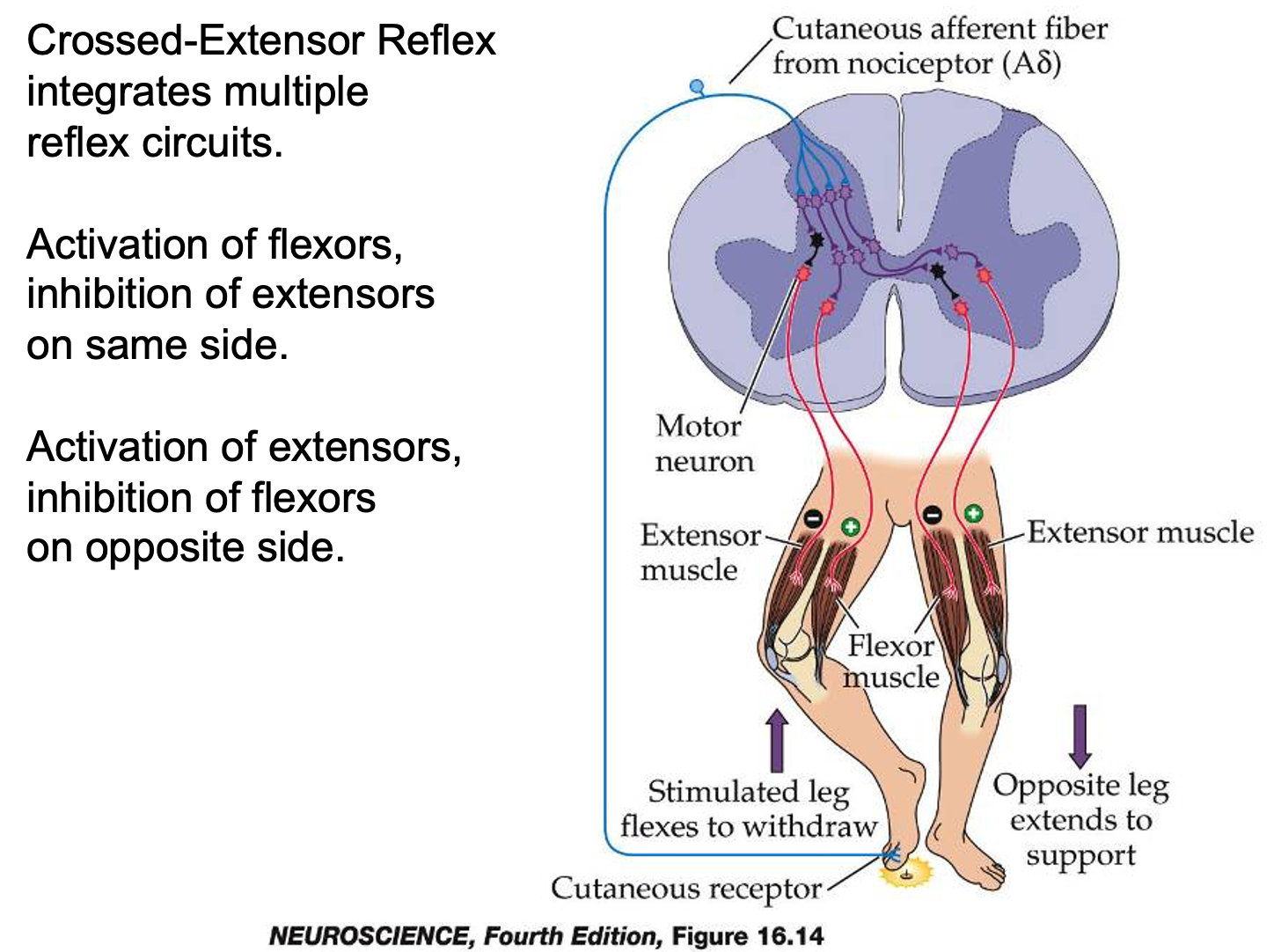
The withdrawal reflex also can be modulated (e.g. partially over-ridden) ________.
For instance, if you touch a hot object, you may draw your hand away quite rapidly. But if you already know the object (e.g. a cup in the microwave) is pretty hot, you may continue to grasp it long enough to voluntarily move it to the table.
In such instances, descending voluntary pathways have _______ the flexor withdrawal reflex.
consciously
inhibited
___________ is the sense of position, force and movement of muscles, limbs and torso.
Proprioception
Proprioception includes:
Length and velocity feedback from muscle spindles (particularly important for accurate judgments of limb position and movement)
Strain information from tendon organs
Minor contributions to proprioceptors:
Sensory feedback about the angles and stresses in joints, via joint receptors (e.g. in fingers)
Skin mechanoreceptors
All the above sensory information generates ____________ to the motor system.
integrated proprioceptive feedback
Joint Receptors:
Proprioceptive _________ are located within joints and overlying skin.
axon branches
Joint Receptors:
Rotation of a joint _______ the joint capsule on one side, and _______ the other side.
stretches
unloads
Joint Receptors:
_________ in these tissues can thus signal the angle, direction and velocity of movement of a joint.
Mechanoreceptors
___________ contribute only minimally to proprioception for some joints, but may be quite important for other joints (especially finger joints).
Joint receptors
RECEPTORS: ____________: sensors for joint angle
Joint Receptors
Patients lacking ____________ from a given muscle can still contract that muscle, but with less accurate position control than healthy people.
This emphasizes the importance of sensory-motor _________.
Information about limb position from _________ in the joints, which change their firing rate with changes in the angle of the joint.
afferent (sensory) fibers
integration
proprioceptors
However, experiments in which joint receptors are temporarily inactivated (by local anesthetics) indicate that the ___________ receptors provide the most critical information for Proprioception, which is the recognition of body (or body part) position.
muscle spindle organ
Recurrent Inhibition of Motor Neurons: ________
Renshaw cells